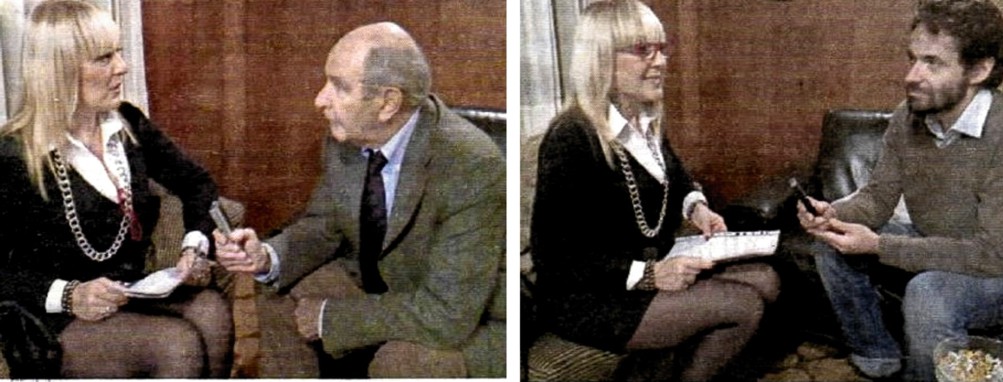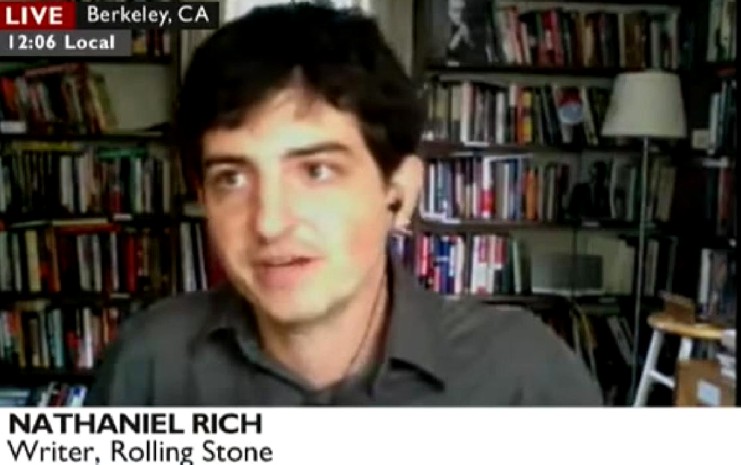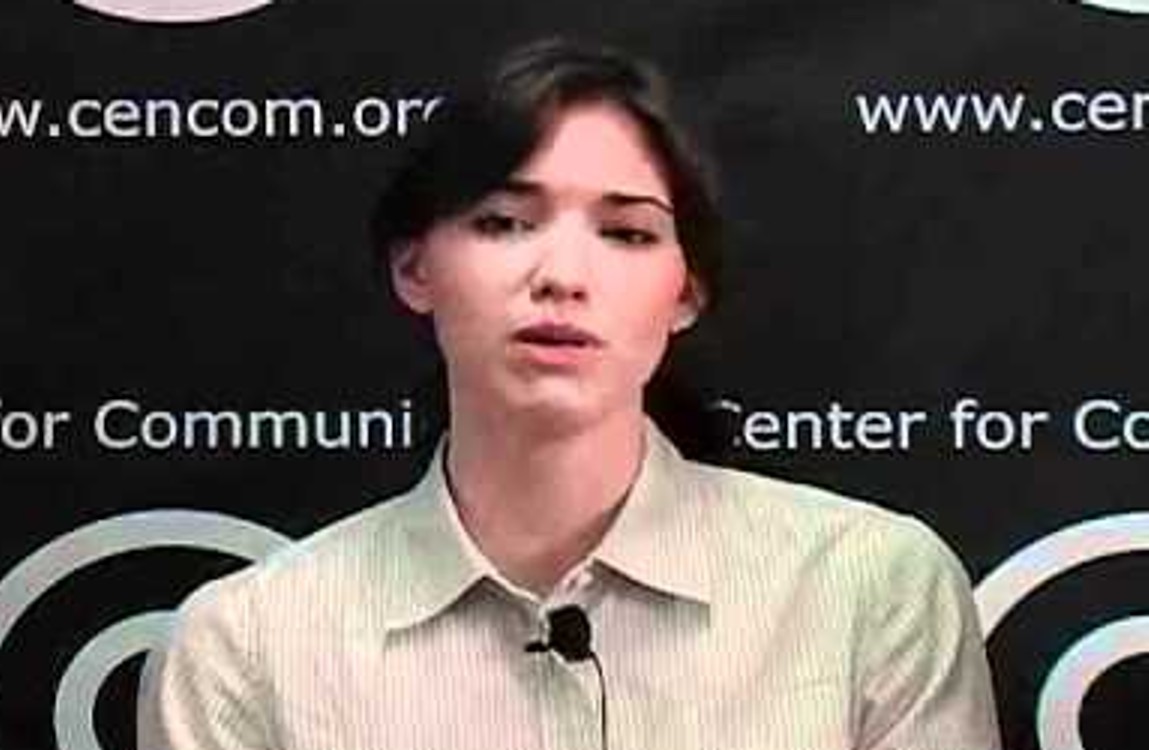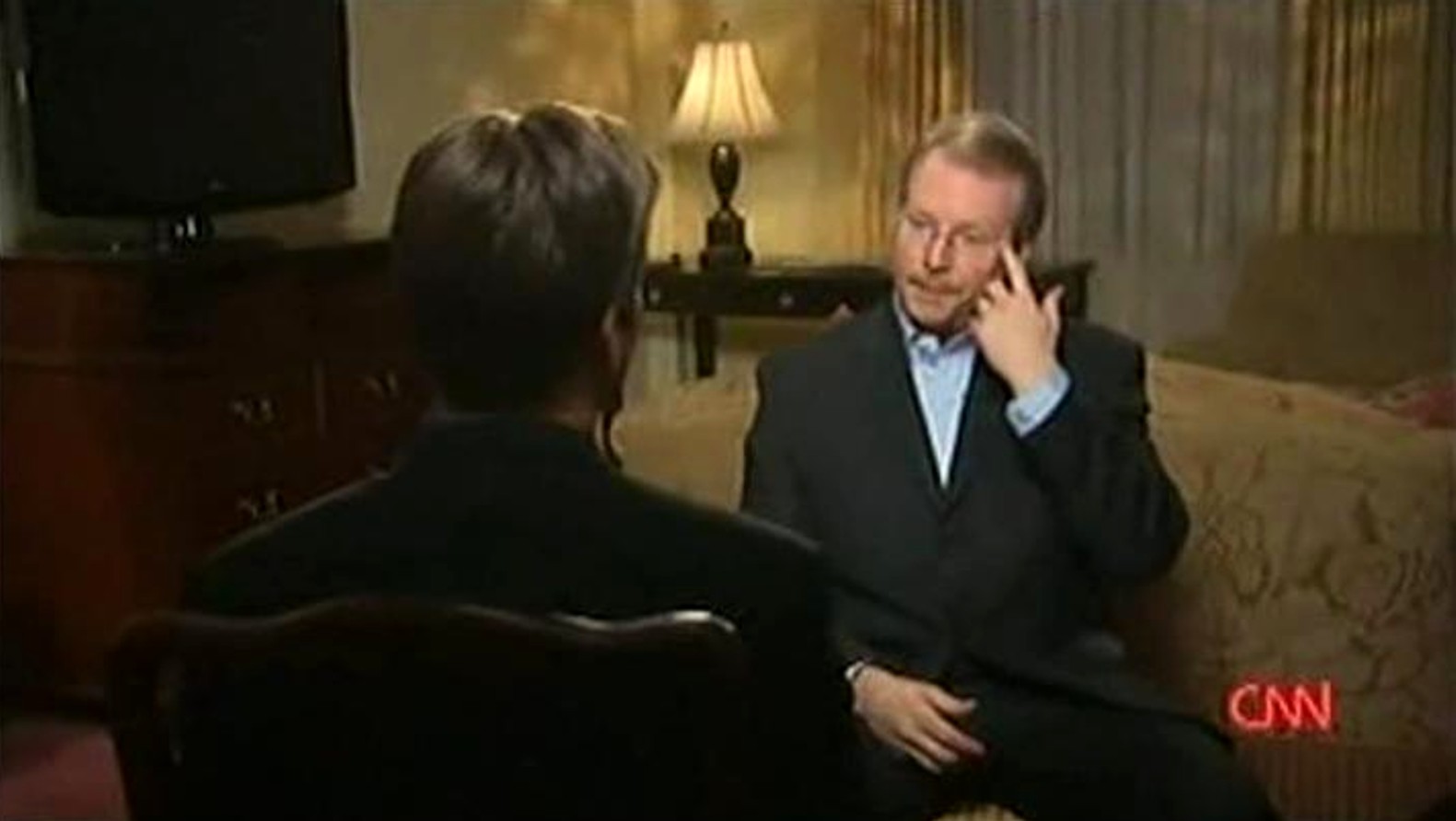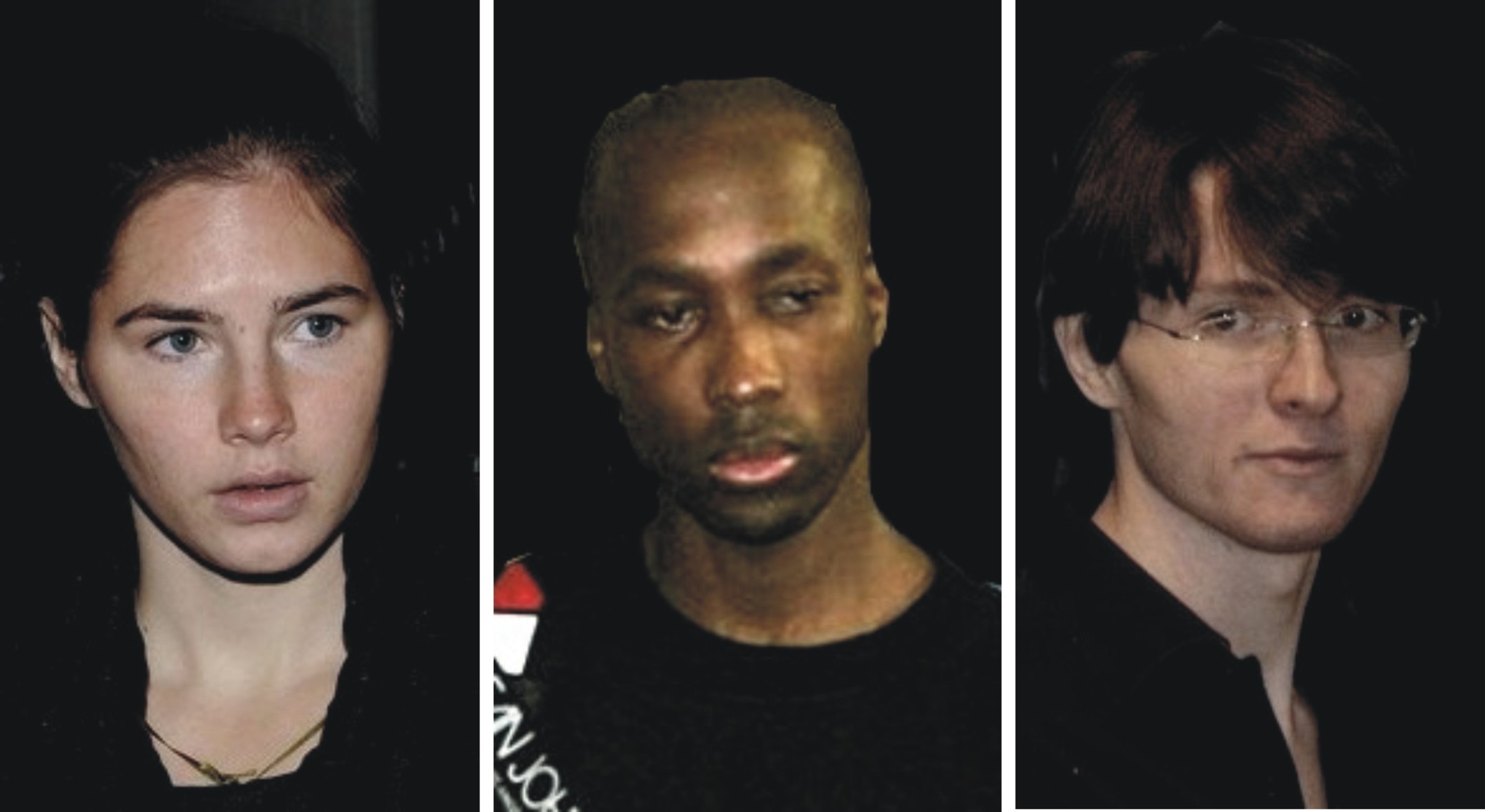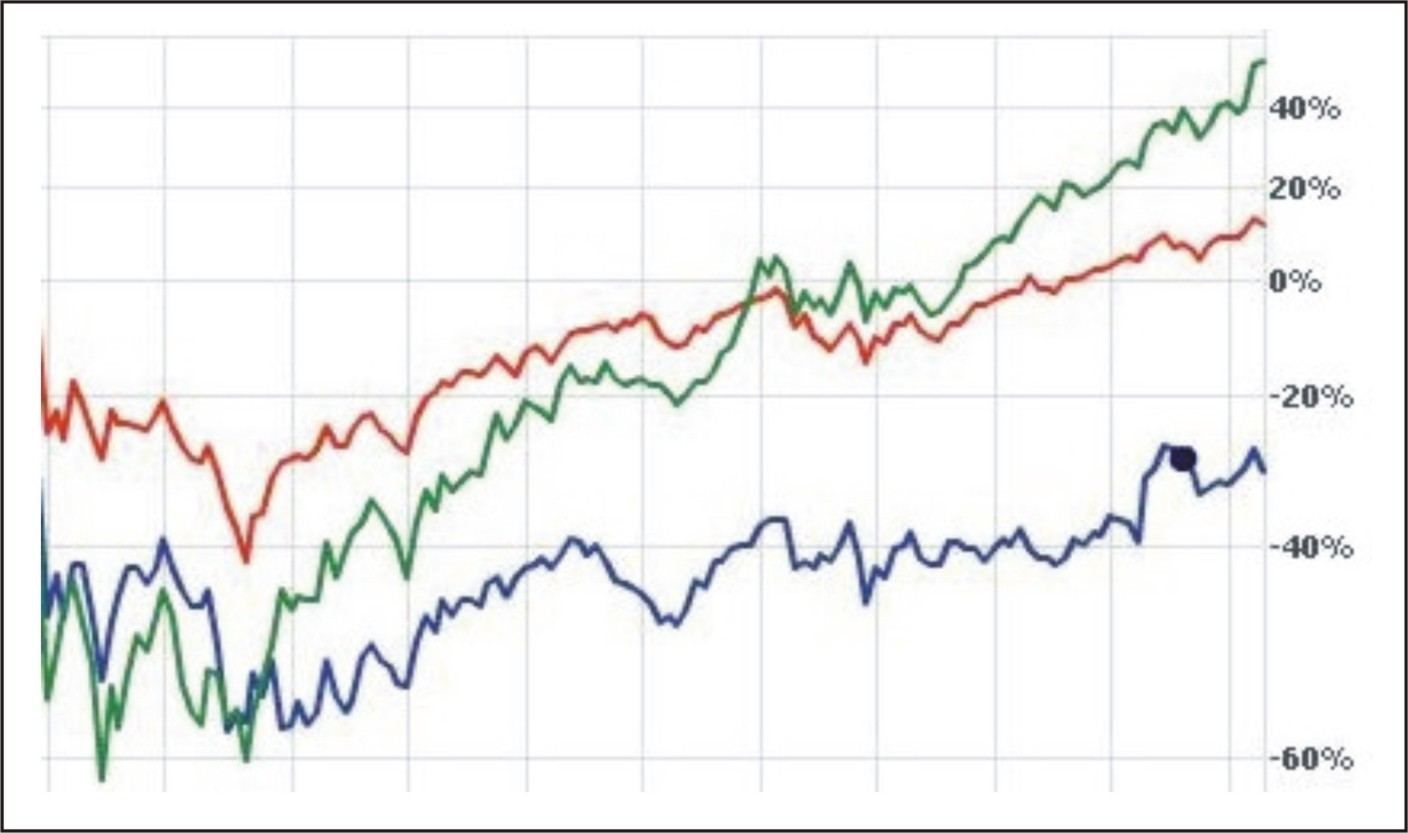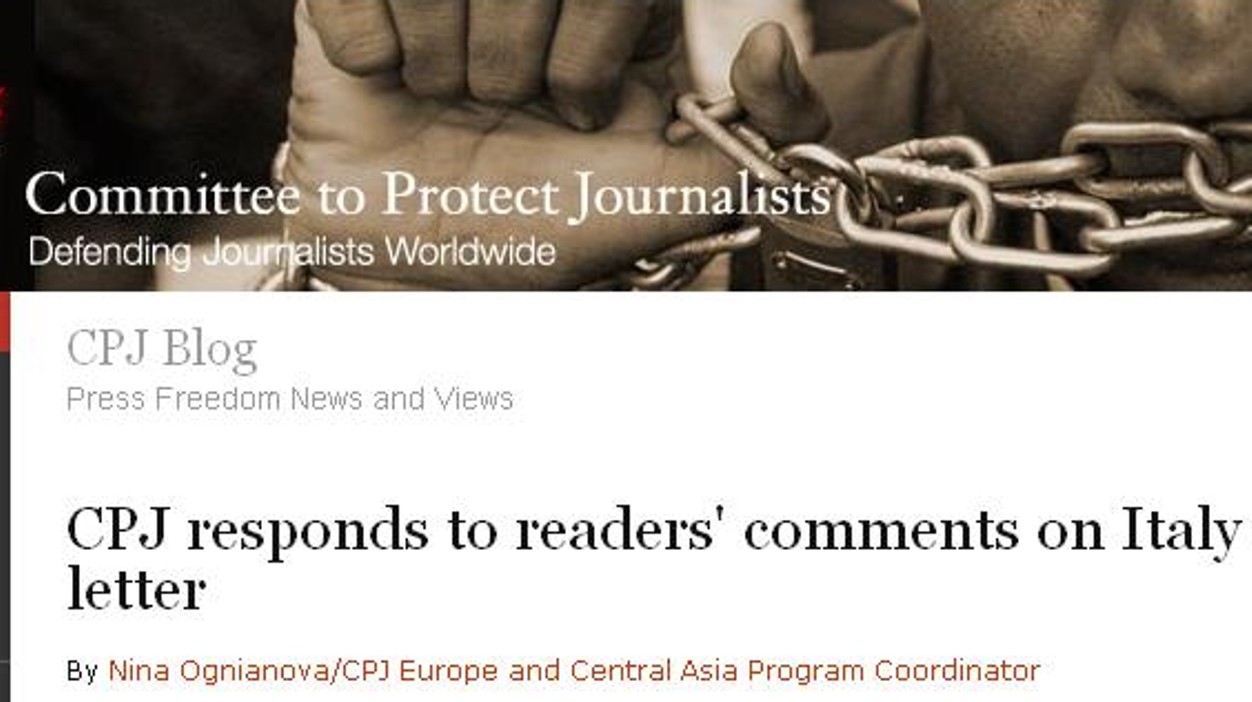
Category: News media & movies
Saturday, December 30, 2017
Why Did The Mainstream Media Enable A Takeover By The Conspiracy Nuts?
Posted by The Machine

How Seattle is misinformed. Exoneration? Riiiight….
Rampant Conspiracies
This condemnation is written in light of the ever-growing wave of translated transcripts.
They show how extremely good the investigation and case at trial really were. And how extremely wrong were too much of the press. Why did mainstream media organisations allow so many conspiracy nuts to spout their unsubstantiated and ridiculously far-fetched claims?
Mainstream media organisations have known for a while that the general public has an insatiable appetite for documentaries about allegedly innocent people who have been convicted of murders they didn’t commit.
A cursory glance at the selection of true crime documentaries on Netflix provides evidence of the appeal of this specific genre. Amanda Knox, West of Memphis and Making of a Murderer are all hugely popular.
The Serial podcast about the Adnan Syed/Hae Mine Lee case is one the most downloaded podcast of all time. Sarah Koenig presented the case from the defence’s perspective and concluded there isn’t enough evidence to convict Adnan Syed of Hae Min Lee’s murder.
The juries in the respective cases above listened to the prosecution and defence present their cases in court.
They weighed the testimonies of the experts and witnesses for both sides and they were all convinced that Amanda Knox and Raffaele Sollecito, Damian Echols, Jesse Misskelley and Jason Baldwin and Steven Avery and Brendan Dassey and Adnan Syed were all involved in exceptionally brutal murders.
There is damning evidence against all the people mentioned above. But many journalists don’t want the facts to get in the way of a good story.
Among The Worst
Paul Ciolino admitted in a question-and-answer session about the Meredith Kercher case at Seattle University that CBS News didn’t care whether someone was innocent. The only thing they care about is the story.
I work for CBS News. I want to tell you one thing about CBS. We don’t care if you did it. We don’t care if you’re innocent. We like a story. We want to do a story. That’s all we care about.
It was recognised as far back as 1999 in the legal profession that journalists have an inclination to slant their reports in favour of the defendants.
P. Cassell, “The guilty and the ‘innocent’: An examination of alleged cases of wrongful conviction from false confessions”, Harvard Journal of Law and Public Policy, 1999:
...academic research on miscarriages should not rely on media descriptions of the evidence against defendants. Journalists will all too often slant their reports in the direction of discovering “news” by finding that an innocent person has been wrongfully convicted.
The default position of mainstream media organisations in the US was that Amanda Knox is innocent despite the fact that the vast majority of journalists who covered the case weren’t in a position to know this - they hadn’t regularly attended the court hearings or read a single page of any of the official court reports.
The news organizations in Seattle was so partisan in their support of Amanda Knox that they were effectively just mouthpieces for the PR firm of David Marriott that was hired by Curt Knox to influence a credulous and naive local audience who felt duty-bound to support the hometown girl.
Lawyer Anne Bremner couldn’t resist the temptation to use the case to promote herself in the media. Judge Michael Heavey was recruited so he could use his position as a judge to sway the public.
The vast majority of people in Seattle were kept completely ignorant of the basic facts of the case by all their newspapers and all their TV news, so they were not in a position to realize that both Bremner and Heavey got basic facts wrong.
Many American journalists who reported on the case hold the ridiculous belief that the US legal system is the only competent and just one in the world, and that no US citizen charged by a foreign court with any crime can possibly be guilty of it or ever receive a fair trial.
The claim that Amanda Knox was being framed for a murder she didn’t commit by corrupt officials in a foreign country by her supporters was manna from heaven for mainstream media organizations in America.
It was a sensational story that was guaranteed to enrage and entertain a gullible American public in equal measure.
It’s not possible to ascertain precisely who originated the story that Amanda Knox was being framed for a murder she didn’t commit by a corrupt legal system.
But it almost certainly came from someone within or very close to Amanda Knox’s family. Jan Goodwin was one of the first journalists to make the claim after interviewing Edda Mellas for Marie Claire in 2008.
Studying abroad should have been a grand adventure. Instead, Amanda Knox has spent a year in jail, accused by a corrupt legal system of murdering her roommate.
Goodwin didn’t offer any evidence to substantiate her claim that the Italy legal system is corrupt, presumably the word of Edda Mellas was good enough for her.
It transpired that the word of Edda Mellas and ex-husband Curt and Amanda Knox’s supporters was good enough for the vast majority of journalists who covered the case on both sides of Atlantic.
They unquestiongly accepted everything they heard without bothering to do any fact-checking whatsoever. Time and again not a single investigator or court official in Perugia was interviewed.
This explains the reason why so many articles about the case are riddled with factual errors and well-known PR lies.
Other media organisations wanted to get in on the act and claim there was dastardly plot to frame Amanda Knox for Meredith’s murder.
CBS News allowed a couple of zany conspiracy nuts to spout their nonsense without providing any evidence to support their wild-eyed claims. Here’s Paul Ciolino again:
This is a lynching ... this is a lynching that is happening in modern day Europe right now and it’s happening to an American girl who has no business being charged with anything. (Paul Ciolino, CBS News.)
Here is Peter van Sant.
We have concluded that Amanda Knox is being railroaded… I promise you’re going to want to send the 82nd Airborne Division over to Italy to get this girl out of jail. (Peter Van Sant, CBS News.)
The reporting was invariably tinged with xenophobic sentiments. Italy was portrayed as some backward Third World country whose police force was comically incompetent. Here’s CBS’s Doug Longhini.
But in the case of Amanda Knox, the American student convicted of murder in Italy last December, the Via Tuscolana apparently failed to separate fantasy from truth. Too many Italian investigators rivaled Fellini as they interpreted, and reinterpreted facts, to suit their own, surrealistic script.” (Doug Longhini, CBS News).
WHERE in all the transcripts is that proved? Doug Longhini’s pompous and pseudo-intellectual comments are meaningless and lack any substance, although he was no doubt very pleased himself for his “clever” reference to Fellini.
Ironically Longhini was unable to separate fantasy from truth when he produced the error-ridden American Girl, Italian Nightmare for CBS News. The documentary includes the familiar PR lies about satanic rituals, the 14-hour interrogation sessions, and Knox not knowing Rudy Guede.
Lawyer John Q Kelly seemingly forgot the Latin maxim “semper necessitas probandi incumbit ei qui agit” - “he who asserts must prove” - when he claimed that Knox and Sollecito were being railroaded and evidence against them had been manipulated.
My thoughts, Larry, it’s probably the most egregious international railroading of two innocent young people that I have ever seen. This is actually a public lynching based on rank speculation, and vindictiveness. It’s just a nightmare what these parents are going through and what these young adults are going through also.
“There’s been injustice here. There’s been injustice in other countries but this is just beyond the pale. The manipulation of evidence; the most unfavorable inferences drawn from the most common of circumstances and conduct was just a gross injustice here.”
(John Q Kelly, CNN).
Judy Bachrach was also allowed to claim there was a conspiracy to Amanda Knox on CNN.
Everyone knew from the beginning that the prosecutor had it in for Amanda Knox, that the charges are pretty much trumped up…
From the beginning this was carefully choreographed, they wanted to find her guilty, they’ve kept her in jail for two years even before trial and they did find her guilty. This is the way Italian justice is done. If you’re accused, you’re guilty.
There isn’t an ounce of hard evidence against her and all of Italy should be ashamed actually.” (Judy Bachrach, CNN).
Arguably the craziest conspiracy nut - and the competition is fierce - is the former FBI agent Steve Moore in early retirement.
Steve Moore claimed the Perugian police, Guilano Mignini, Dr Patrizia Stefanoni, Edgardo Giobbi the head of the Violent Crimes Unit in Rome, Judge Massei, and the Italian Supreme Court were all part of a dastardly plot to frame Amanda Knox.
Moore claimed the following on his blog.
For this to happen, though, pompous prosecutor Giuliano Mignini, forensic perjurer Patrizia Stefanoni, and mind-reading detective Edgardo Giobbi (and others), must be prosecuted for their corruption. The judge who rubber stamped the lies in the first trial, Massei, must be also called to the bar of justice-or back to law school.
In a discussion with lawyer Paul Callan on CNN Moore actually claimed the Supreme Court was involved in the conspiracy.
Paul Callan: “And now “¦ and they (the Perugian police) got the Supreme Court of Italy involved in this conspiracy? You know, that’s like saying that “¦ [Steve Moore interrupts]”
Steve Moore: “Yes, they do. Yes, they do. You are being naive. You don’t understand the Italian system. You don’t understand it. You are defending something you don’t understand.”
Barbie Nadeau reported Moore’s claim that evidence was manipulated for The Daily Beast.
The evidence that was presented in trial was flawed, it was manipulated.
Steve Moore has never provided any evidence to support his wild-eyed hysterical claims there was a huge conspiracy involving a prosecutor, different police departments, Judge Massei and judges at the Italian Supreme Court to frame Amanda Knox for Meredith’s murder.
It’s no wonder TV legal analyst Paul Callan was smiling, desperately trying not to burst out laughing, when he discussed the case with Moore on CNN.
Moore provided irrefutable proof in the short time he was on CNN that he is ignorant of the basic facts of the case, and that he hasn’t read any of the official court reports. He falsely claimed “the DNA that they said was Raffaele’s was actually a woman’s DNA.”
No expert claimed this at the trial.
Sollecito’s DNA was identified by two separate DNA tests. Of the 17 loci tested in the sample, Sollecito’s profile matched 17 out of 17. David Balding, a professor of Statistical Genetics at University College London, analysed the DNA evidence against Sollecito and concluded it was “very strong”.
Moore told Erin Burnett: “The second trial proved with independent experts that the DNA that they claim was the victim’s was not on the knife.”
A number of forensic experts - Dr Stefanoni, Dr Biondo, Professor Novelli, Professor Torricelli, and Luciano Garofano - have all confirmed that sample 36B which was extracted from the blade of the knife WAS Meredith’s DNA. The independent experts did not carry out a test on this sample.
In England there were deranged conspiracy nuts claiming Amanda Knox was framed too.
Amy Jenkins bizarrely claimed in The Independent that Knox and Sollecito were the victims of a miscarriage of justice because Knox was a young woman, the Italians didn’t like the fact Knox snogged her boyfriend and someone needed to save face or something.
The truth is, Amanda Knox’s great crime was to be a young woman ““ but mainly it was to be a young woman who didn’t know how to behave. She was 20 years old, she was suffering from shock, and she was in a foreign country. She was interrogated with no lawyer and no translator present. She made a phony confession.
Clearly no saint, she wasn’t a Madonna either. That’ll make her a whore then. She snogged her boyfriend; she was slightly provocative on Facebook; she turned an inappropriate cartwheel. In a Catholic country, it’s clearly not such a leap to go from there to stabbing your room-mate in the neck during a violent sexual assault ““ because that’s the leap the prosecution made.
To save face, Knox and her poor boyfriend had to be somehow levered into the frame. As the whole juggernaut of injustice chugged on it became harder and harder for the six lay judges who acted as a jury to destroy a case that had been constructed over two years by prosecutors who were their close working colleagues.” (Amy Jenkins, The Independent).
Conclusion: READ THE DOCUMENTS
More and more the translated documents prove that all of them have been wrong. The conspiracy theorists predictably haven’t provided one iota of evidence that there was ever any conspiracy to frame Amanda Knox for Meredith’s murder.
I suspect the producers at mainstream media organisations like CBS News and CNN knew there never was any conspiracy to frame Amanda Knox all along, but they didn’t get care because they wanted a sensational story.
Too many people within the media perversely see murder as entertainment. Rather than providing balanced and factually accurate coverage of murder cases they want to outrage and entertain the masses with melodramatic stories of conspiracies involving corrupt prosecutors and cops who want to frame innocent people for murders they didn’t commit instead.
We shouldn’t be surprised by the popularity of Making of a Murderer on Netflix. It filled a vacuum after Knox and Sollecito were acquitted in 2015.
I have no doubts that journalists from mainstream media organisations are currently looking for the next alleged case of someone being framed or railroaded for a murder they didn’t commit.
Thursday, September 01, 2016
How Bob Woffinden, Aggrandizing Investigative Journalist, Attempts To Perpetrate Innocence Fraud
Posted by The Machine
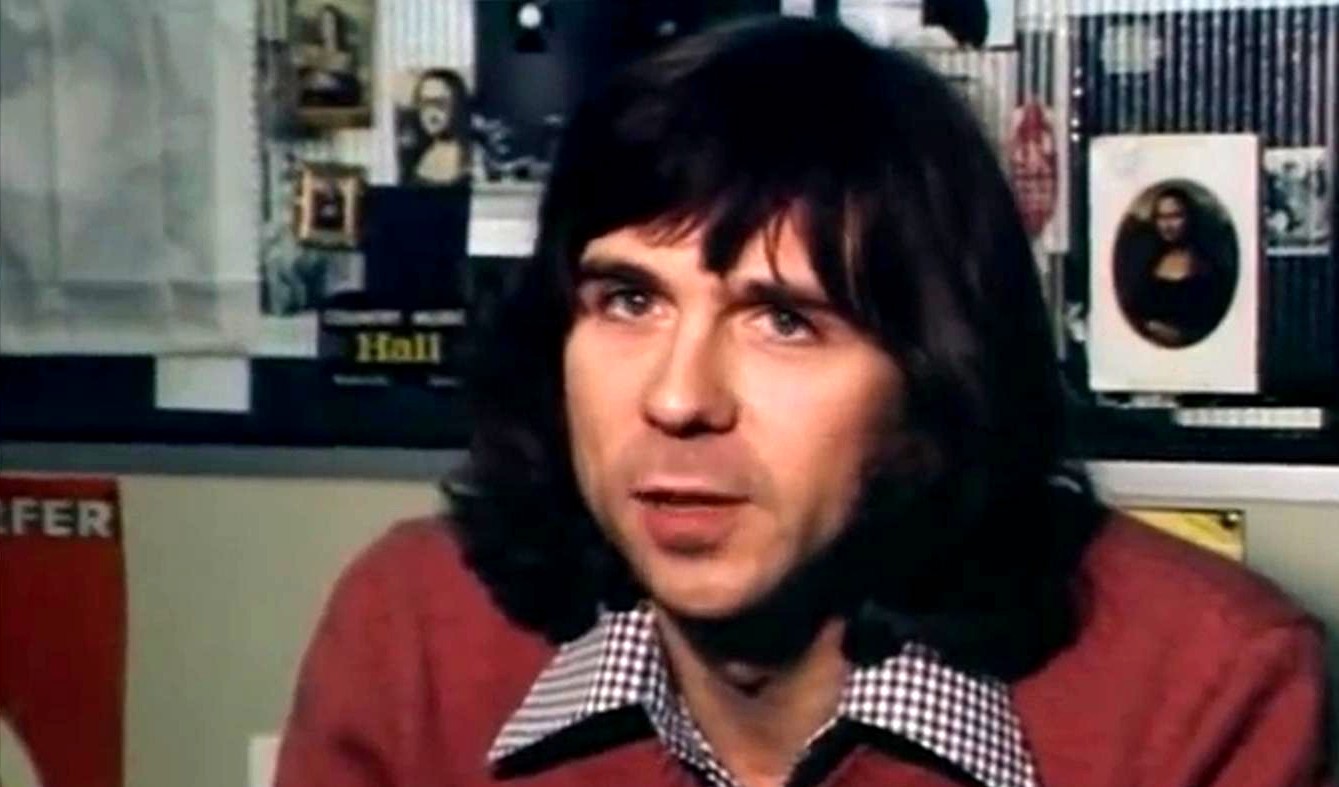
Said to be Bob Woffinden - as a pop music reporter, some years ago
Added in 2018. Bob Woffinden died on 1 May. He never reversed his false claims about Guede. His website was later taken down.
1. Woffinden and innocence fraud
These days innocence fraud is a very real thing.
A stern warning was issued to crime laboratory administrators that some post-conviction exonerations may have been secured by innocence activists using malicious tactics, or ‘innocence fraud’, creating potential public safety threats as convicted felons are released from prison.
In this post, I will analyse another example of innocence fraud, this time by British journalist Bob Woffinden on Meredith’s case. Woffinden has done this on other cases before.
He specialises in alleged miscarriages of justice, and has written articles for The Guardian, The Daily Mail and The New Statesman and authored a number a books about high-profile murder cases: Miscarriages of Justice; Hanratty: The Final Verdict and The Murder of Billy-Jo.
Woffinden’s default position when it comes to controversial murder cases seems to be to assume a miscarriage of justice, and to claim someone has been convicted of a crime they didn’t commit.
He’s claimed that James Hanratty, Jeremy Bamber, Barry George, Sion Jenkins and Jonathan King are all innocent. Reflexively anti-police, Woffinden as I described in the post linked to above on the James Hanratty case has a history of putting victims’ families through considerable pain.
2. Woffinden On Meredith’s case
Here he tries to prove that Rudy Guede is innocent of murder, and falsely claims he was convicted because he was black. He also tries to cast doubt on the hard fact that Meredith was sexually assaulted - or that the police got anything right.
Anyone who has read the official court documents and court testimonies with regard to the Meredith Kercher case will be able to assess Bob Woffinden’s professionalism and credibility and ethics as an investigative journalist article by reading his contorted take.
To those who really do know the case, it is immediately apparent that he’s pretty ignorant of the main facts, and that he hasn’t bothered to read the official court documents or the court testimonies available in English here.
He mindlessly repeats various endemic Friends of Amanda PR myths. For example, he erroneously claims the prosecutors concocted the scenario of a sex orgy gone wrong.
“The second mistake then ensued from the first. Needing to explain the presence of their three suspects in connection with the supposed sexual assault ““ and knowing there was absolutely no evidence to link Guede with Knox and Sollecito ““ they [the prosecutors] concocted the absurd scenario of a sex orgy gone wrong.”
Dr Mignini didn’t ever say anything about there being a sex orgy that went wrong when he presented his scenario to the court at the trial in 2009 and the numerous hearings (which Woffinden seems totally unaware of) in the 15 months before.
Instead he gave the court a detailed chronological account briefly summarized below of a vicious physical and sexual assault on Meredith, which culminated in her dying some time after the killers left and locked her in.
23:21: Amanda and Raffaele go into the bedroom while Rudy goes to the bathroom.
23:25: A scuffle begins between Amanda, helped by Raffaele, and Meredith. The English girl is taken by the neck, then banged against a cupboard, as shown by wounds to the skull. She resists all this. Rudy Guede enters.
23:30: Meredith falls to the floor. The three try to undress her to overcome her; they only manage to take off her trousers. The girl manages to get up, she struggles. At this point, the two knives emerge from the pockets of Amanda and Raffaele: one with a blade of four to five centimetres, the other, however, a big kitchen knife. Meredith tries to fend off the blades with her right hand. She is wounded.
23:35: The assault continues. Sollecito tries to rip off the English girl’s bra.
23:40: Meredith is on her knees, threatened by Amanda with the knife while Rudy holds her with one hand and with the other hand carries out an assault on her vagina. There is first a knife blow on her face, then straight away another. However, these blows are not effective. The three become more violent. With the smaller knife, Sollecito strikes a blow: the blade penetrates 4 centimetres into the neck.
There is a harrowing cry, which some witnesses will talk about. Amanda decides to silence her, still according to the video brought to court by the prosecutors, and strikes a blow to the throat with the kitchen knife: it will be the fatal wound. Meredith collapses on the floor.
23:45: Meredith is helped up by Rudy and is coughing up blood. The English girl, dying, is dragged along so that she can continue to be undressed.
Why is Woffinden unable to substantiate his claim that the prosecutors concocted the scenario of a sex orgy gone wrong with a verbatim quote from Mignini or Comodi?
Because they never claimed this at all. A competent and ethical professional journalist should be able to support every claim they make.
Woffinden regurgitates another popular PR myth by claiming that Rudy Guede pleaded guilty late in 2008.
“Even as he [Rudy Guede] pleaded guilty, he vehemently asserted his innocence, saying, “˜I can’t talk about things I haven’t seen and that didn’t happen to me’.”
Rudy Guede has never pleaded guilty or confessed to Meredith’s murder. He has always denied killing Meredith. He opted for a fast-track trial in mid 2008 because he could escape a blatant attempt to frame him as sole perpetrator by the Knox and Sollecito defense.
It meant he would automatically received a third off his prison sentence but at the time he had no idea what that would look like.
Bob Woffinden gets yet another fact wrong when he claims the Hellmann appeal court sanctioned a full review of the scientific evidence.
“...the Italian court sanctioned a full review of the scientific evidence on which they had been convicted.”
It did nothing of the kind. Hellmann merely asked Carla Vechiotti and Stefano Conti to review two pieces of DNA evidence - the knife and bra clasp evidence.
They didn’t review the bloody footprint on the bathmat, the bare bloody footprints which had been revealed by Luminol, or the five samples of Knox’s DNA or the blood mixed with Meredith’s blood in three different locations in the cottage.
Yet another wrong “fact”. Bob Woffinden claims that a police officer flushed away Rudy Guede’s faeces and thus destroyed evidence.
“His recollection that he had leapt up from the toilet seat the instant he heard the scream was bizarrely corroborated by the fact that there were faeces still in the pan when the police arrived. Needless to say, one officer activated the toilet, thereby flushing away important evidence.”
Needless to say? In fact this claim is complete and utter nonsense. The faeces in the toilet wasn’t flushed away. It was carefully collected as evidence and tested. However, it didn’t yield any results.
“The faeces present in the toilet of that bathroom did not, however, yield any results, and Dr Stefanoni, the biologist of the Scientific Police, explained that the presence of numerous bacteria easily destroys what DNA might be found in faeces.” (The Massei report, page 43).
Why would Woffinden make these and other demonstrably untrue claims? It seems obvious that he wants to portray the Italian National Scientific Police (much respected by the FBI) as the Keystone Cops, in order to ridicule the forensic investigation, seemingly his purpose here.
Woffinden makes yet another false claim by stating that Guede made only one inconsistent statement.
“Guede’s solitary inconsistency was this. He did comment at the outset of the investigation that “˜Amanda doesn’t have anything to do with it’. But, at that stage, perhaps he couldn’t believe that she did have.”
Judge Micheli, who found Rudy Guede guilty of sexual assault and murder in October 2008, pointed out in his sentencing report of January 2009 that Guede’s accounts were unreliable and varied a lot.
“Analyzing the narratives of the accused”¦he is not credible, as I will explain, because his version is (1) unreliable, and (2) continuously varying, whether on basic points or in minor details and outline.”
Bob Woffinden also seems to be pushing the wrong notion that Rudy Guede didn’t implicate Amanda Knox until much later - which is another FOA PR myth.
Guede first implicated Amanda Knox and Raffaele Sollecito whilst on the run in Germany on 19 November 2007 in an intercepted Skype conversation with his friend Giacomo Benedetti:
Giacomo: “So they [Knox and Sollecito] killed her while she was dressed.”
Guede: “Yes, here it says that they [clothes] were washed in the washing machine, but that’s not true. She was dressed.”
Bob Woffinden makes the erroneous and offensive claim that there’s no evidence that Meredith was sexually assaulted,
“In their investigation, prosecutors made a series of blunders. The first serious mistake was their assumption that Meredith was sexually assaulted. If one takes cognisance of Guede’s account, there is no evidence of this. The second mistake then ensued from the first. Needing to explain the presence of their three suspects in connection with the supposed sexual assault ““ and knowing there was absolutely no evidence to link Guede with Knox and Sollecito ““ they concocted the absurd scenario of a sex orgy gone wrong.”
Had Bob Woffinden actually bothered to read the key Massei trial report, he would have known that several medical experts - Dr Lalli, Professor Marchionni, Professor Bacci and Professor Gianaristide Norelli - testified that there were indications of sexual violence on Meredith.
Such conclusions were further explained [by Dr Lalli] at the hearing of April 3, 2009, in which it was highlighted that signs were present of sexual activity with characteristics of non cooperation by the young woman, which can be derived from the lesion pattern at the vulvo vaginal level (page 40 of transcripts).
[111] These signs were present in the purple ecchymotic type spots detected on the inner surface of the labia minora, the area where they are usually produced. It is the first point of contact for the sex organ or object including fingers penetrating the vagina and therefore the point at which an action ... performed without the full cooperation of both actors would produce purplish spots of this kind. (The Massei report, page 116).
He [Professor Marchionni] noted in this regard that, even without lubrication injuries of this nature are not the result of consensual sexual intercourse, and he argued that the cause of these lesions had originated from a “forcing” that could have been done by the penis or by hands (page 21, hearing on April 4, 2009). (The Massei report, page 117.)
With regard to sexual violence, he [Professor Bacci] referred to the inspection of the genital area conducted by Dr. Lalli at the morgue operating room. On the internal surface of the labia minora, attention was focused on areas of discolouration, which can be interpreted as small bruises, small abrasions associated with small haemorrhages indicative of “small lesions” (page 16, transcripts) consistent with a violent action of friction, pressure an typical of sexual violence and, while affirming the absence glaring signs of typical sexual violence (page 16, transcripts) he concluded compatibility with non-consensual sexual intercourse’ (page 16, hearing, hearing on April 18, 2009). (The Massei report, page 121.)
He [Gianaristide Norelli] further underlined the presence of a slight bilateral suffusion in the area of the iliac spines, i.e. in the areas corresponding to the anterior lateral part of the flank, which represent the end/terminal parts of the wings of the [pelvic] basin and the fact that “lesions in this area are fairly characteristic of seizure [grasping] and immobilisation”; [it is] an area which is “˜highly suggestive’ in the context of the investigation of sexual assault. (The Massei report, page 124).
It should be stressed that the the doctor who actually performed the autopsy - Dr Lalli - believed Meredith had been sexually assaulted.
“The prosecution focused on Lalli’s statements that he believed there had been non-consensual sex.” (Andrea Vogt, The Seattle Post-Intelligencer, 2 April 2009).
You need just an ounce of common sense to know that murder victims who were also raped or sexually assaulted didn’t consent. The Kerchers’ lawyer Dr Maresca made this very point:
“Sex that ends with someone dead is not consensual.”
Dr Maresca also highlighted the fact several medical experts said there were signs of sexual violence in court. Dr Maresca told the court that the expert witnesses
“sustained the prior results and valuations of the coroner who performed the autopsy and the forensic evidence specialists who already testified”. He added: “And for the first time today, we also heard that the bruises on the victim’s hips were consistent with a sexually violent approach.”
Unbelievably, Bob Woffinden regards Rudy Guede as a reliable and credible witness.
I’m surprised anyone would believe Guede’s ever-changing versions of events when they are so blatantly untrue. Guede gave two different accounts of arranging a date with Meredith and they’re both demonstrably false.
Meredith didn’t go to the Halloween party at the Spanish students’ house on 31 October 2007.
Guede then changed his story and claimed that he had met her at Domus, but Meredith was with her friends continuously and none of them saw her with him. None of Guede’s friends saw him with her either.
“He [Rudy Guede] stated that he met the girl on Oct. 31 in the house of some Spanish students and did not meet her later in the “Domus” pub, that the next day, shortly before going to the date with Meredith…
In the third interrogation, by the P.M. [public prosecutor] on March 26, 2008, he changed the place of his meeting with Kercher on Oct. 31 from the Spanish students’ house to the Domus pub” (Judge Giordano’s Supreme Court report, page 17).
“...and also because none of Meredith’s friends (Amy Frost, Robyn Butterworth and [10] Sophie Purton, with whom she had gone out on the evening of Halloween, Oct. 31, 2007) nor any of Guede’s friends (among others AC and PM) had ever seen them talk to each other.” (Judge Giordano’s sentencing report, page 10).
Meredith had NOT arranged a date with Guede at the cottage on Via della Pergola on 1 November 2007. She and Sophie Purton left their friends early that evening because they mistakenly believed they had lectures the next day.
“They [Meredith Kercher and Sophie Purton] were to meet on the morning of the second at around 10:00 am for a lecture at the university…:” (The Massei report, page 35).
“Meredith was tired from the day before when she had come home about five in the morning; the next day she supposed that she had a lesson at the University at 10 am and she needed to prepare for this and she had to also think about resting” (The Massei report, page 58).
Judge Massei explained at length in his report why Rudy Guede’s claims he had a date with Meredith were not credible.
“Speaking of Meredith, there has already been occasion to make mention of her personality (serious, not superficial, with a strong character), of her romantic situation [i.e. her love life] (she had not long beforehand begun a relationship with Giacomo Silenzi), of the plans she had for that evening (studying, preparing for the following day believing that there would be classes at the University, finishing a piece of homework, as her mother recalled during the hearing of 6 June 2009, and resting).
None of the people she frequented and in whom she confided (her relatives and her English girlfriends) testified that Meredith had made any mention to them at all of Rudy, for whom, therefore, she must not have felt any interest. With regard to the totality of these circumstances, it must be considered that Meredith could only have made an outright refusal to Rudy’s advances” (The Massei report, pages 365-366).
In rejecting Guede’s final appeal Judge Giordano succinctly summarised the reasons why he was found guilty of sexual assault and murder in his Supreme Court report. It had nothing to do with the colour of his skin.
“The judgement rationale thus proceeds through rigorous logical steps, quite consistently, with no possibility of misinterpreting evidence, distorting significant data, or disruption of the overall probative reasoning. Meredith Kercher, before being slaughtered with the deadly blow at her throat, was the victim of a series of wounds, of forced restraining of her limbs, especially the left hand and arm - and on the cuff of the left sleeve of the sweatshirt she wore clear traces of DNA of the defendant are found ““ aimed at overcoming her resistance to sexual violence, of which the traces of DNA of Guede of the vaginal swabs are evidence, which then led to the violent behaviour of the deadly slaughtering.
The version of the accused is totally unrealistic because, even apart from the obvious omissions and contradictions detectable in his many statements, his previous acquaintance of Meredith, shaped in his story by a meeting on the night before the murder at the Domus pub, by a kiss between the two and by a date for the evening of the following day, is clearly disproved by a whole articulated testimonial structure, [19] coming from several people and indicating that: the two did not meet at the Domus (indicated by the testimonies of all the friends who were accompanying Meredith), even less did they converse, even briefly, at the Shamrock pub during the match between England and South Africa broadcasted the day before (indicated by the testimonies of AC, PM and F), and Kercher never confided anything, as would have been natural, to her friends about a date with Guede, not even on the afternoon of Nov. 1, as she had done in other occasions about details of her personal and love life (indicated by the testimonies of Robin Carmel Butterworth, Sophie Purton).
This is consistent with the portrait of Meredith’s character; she avoided sexual relations with other men apart from Giacomo Silenzi with whom she had begun a relationship that she absolutely did not mean to betray, as stated by her friends, especially not for unimportant adventures.” (Judge Giordano’s Supreme Court report, pages 17-18).
Some conclusions
Bob Woffinden has made a name for himself by publicly championing the causes of convicted killers and sex offenders. Mainstream media organisations such as The Guardian, The Daily Mail and The New Statesman have given him a certain degree of credibilty and respectabilty by publishing his articles. Many people will trust him and assume that he’s a reliable and trustworthy journalist.
However, their trust is misplaced. His lack of due diligence with regard to his article about Rudy Guede and the Meredith Kercher case is disturbing and unacceptable. He doesn’t get the basics of journalism right - which is astonishing for someone who has worked as a journalist for decades. He gets basic facts wrong and he has made numerous demonstrably false claims.
A professional journalist should be able to substantiate every claim they make. Bob Woffinden is unable to do this because he has relied on some of the numerous factually inaccurate articles and the massive defense and PR spin about the case instead of the official court documents and court testimonies.
It defies belief that he accepts Rudy Guede’s fairy tale version of events. You don’t expect such childlike naivety from an adult let alone an investigative journalist. He’s obviously blissfully ignorant of the fact that Guede gave contradictory and confllcting accounts.
It seems he has a deep-rooted psychological need to believe in innocence and police malfeasance, which completely clouds his judgement to the point where he blindly supports and campaigns on behalf of people who are blatantly guilty of sexual assault and murder like James Hanratty and Rudy Guede.
If there’s a more sloppy and self-serving journalist in the world, I haven’t come across them yet.
Saturday, January 09, 2016
How A Major Media Controversy In The US Augurs Well For The Imminent Reframing Of The “Knox Case”
Posted by Our Main Posters
1. The Wisconsin Case Now In Dispute
1. The Netflix Report
In mid December a pay-per-view documentary about a murder case in Wisconsin was put online.
Millions of people in the US and elsewhere have paid up and watched the 10-hour Netflix report. Convinced that they are experts now on the whole case, hundreds of thousands of Americans have signed petitions to the President and the State Governor requesting that the convicted Steve Avery be released.
Some viewers have even taken to berating and threatening the investigators and the prosecution both online and in telephone messages and texts.
Their take seems to be of the investigators and the prosecution corruptly making many, many things up during the investigation and trial. Their supposed motive was to cover their tails in a previous case where Steve Avery was indeed wrongly convicted, for which they could now face court and loss of jobs.
Furthermore some reports claimed that a juror had said the jury felt intimidated and were never convinced of guilt.
2. Reaction Of US Media
A growing wave of reports and articles have been aired and published online in effect saying most of the hardest evidence was left out.
The lead prosecutor has been quoted as saying “90 percent of the evidence” against Avery and a relative convicted as an accomplice was not even mentioned in the report.
So a wave of fact-checking is going on.
Even though it is still early days here and here are Time Magazine. Here is the Los Angeles Times. Here is the New York Times. Here is On Milwaukee’s website. Here is the International Business Times.
Several TV documentaries contradicting the Netflix report are reportedly already in the works. See the reports here and here and also here.
And the juror has now denied that the jury was intimidated and did not do an honest job. So far, all the jurors seem to be standing by their verdict, in the face of a lot of heat.
Oh and on those petitions which Netflix stirred? President Obama’s spokesman has said it is not a Federal case so he will not intervene, and the Governor of Wisconsin has said he will not intervene either, as the state has good justice systems in place.
So they will ignore opinion that was deliberately muddled for commercial ends, and instead leave matters to the courts.
2. Parallels To Reporting Of The “Knox Case”
The parallels to the Perugia case are in fact immense.
The prosecution case in 2009 was extremely persuasive and the entire jury (panel of judges) voted for guilt. They sat through the very tough and convincing 1/4 of the trial that was held behind closed doors.
A majority of Italians still believe that Amanda Knox led a cruel pack attack on Meredith and (to Guede’s and Sollecito’s seeming considerable shock) landed the fatal stab in Meredith’s neck. They watched Knox on the stand for two days, in fact doing herself great harm.
In contrast, almost the entire American media followed the Netflix route.
Main media have struggled to report the trial for language and local-staff reasons, and the Associated Press carried by 2000 media outlets actively misled. Main media presented almost no reporting of the very painstaking judicial checking by ten judges that preceded the case ever going to court.
Main media have still not translated not even one major document (the Wiki and two PMFs and TJMK have translated hundreds of documents now and are still not done) and have left hundreds of evidence points unaddressed.
Main media have also misreported the overturning of the Hellmann outcome and the Nencini appeal. They have especially misrepresented the supposed complete Marasca-Bruno reversal for the Fifth Chambers of the Supreme Court.
As lawyers for Dr Mignini and three of our main posters (James Raper, Machiavelli and Catnip) have shown, in fact the Fifth Chambers (a) should not even have had the case; (b) broke two laws, (c) misinterpreted a few elements of the evidence, (d) left literally hundreds of evidence points out, (e) went against strongly established Italian legal precedents, and (f) even ridiculed plain hard science.
And even so, they still placed Knox right at the scene of the attack at the time, and Sollecito probably so. Accessories before or after the crime. Felons in their view in fact.
So here’s a prediction on what Americans will see in the media soon on this case.
The widespread media reaction against Netflix will be reflected in a major correction in the main media against the serious under-reporting and misreporting of the Perugia case.
We have some idea of what is already in the works. Stay tuned.
Wednesday, April 15, 2015
Dupe Watch: Professional Fraud Exposer Benjamin Radford Himself Gets Seriously Duped
Posted by Peter Quennell
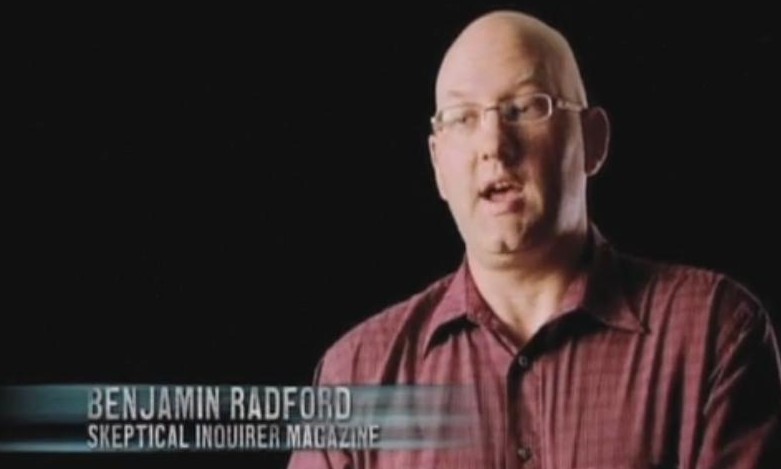
Despite vast, easily accessible evidence to contrary, Radford regurgitates proven Knox lies
1. Who Is Benjamin Radford?
Benjamin Radford is the deputy editor of the popular Skeptical Inquirer which has very active Twitter and Facebook presences.
In normal cool-minded mode, he is an effective and useful exposer of hoaxers and dupes and a good entertainer. He himself has seemed fairly impervious to hoaxes. From his website here are his career highlights.
Benjamin Radford is deputy editor of Skeptical Inquirer science magazine and a Research Fellow with the non-profit educational organization the Committee for Skeptical Inquiry. He has written over a thousand articles on a wide variety of topics, including urban legends, the paranormal, critical thinking, and media literacy.
He is author of six books [including]: Hoaxes, Myths, and Manias: Why We Need Critical Thinking; and Media Mythmakers: How Journalists, Activists, and Advertisers Mislead Us; and The Martians Have Landed! A History of Media-Driven Panics and Hoaxes…
Just our kind of guy, right? In this case, so badly needed. Such a huge opportunity for him. And yet…
2. Radford Swallows The Interrogation Hoax
A dozen deliberate PR-inspired hoaxes (there are also others) to the advantage of Knox and Sollecito are taken apart on TJMk under this right-column heading.
Radford would seem to have very fertile territory there. But instead, Radford himself becomes the latest dupe of the Knox Interogation Hoax.
Instead of actually doing any checking, Radford simply quotes one of Knox’s numerous dishonest and easily disprovable accounts which have already cost her three years in prison and the prospect of more court action ahead for her.
This false statement appeared yesterday in an article by Radford on the Discovery Channel website titled NYC Murder Trial: The Problem With Confessions
The Amanda Knox Confession
False confessions can, of course, have serious consequences for the person who wrongly confesses, but can also pose a real threat to innocent people. That’s what happened in the case of Amanda Knox, the American woman arrested for the 2007 murder of student Meredith Kercher in Italy.
After an extended interrogation Knox confessed to police that she was there during the time of the murder. She implicated not only herself but also Patrick Lumumba, the owner of a bar she worked at, saying she was present when Lumumba murdered Kercher and could hear her screams. Lumumba, however, was cleared weeks later when a university professor came forward to report that he was with Lumumba in his bar at the time of the murder.
Knox later claimed that her confession had been false and coerced: “In regards to this “˜confession’ that I made last night, I want to make clear that I’m very doubtful of the verity of my statements because they were made under the pressures of stress, shock and extreme exhaustion. Not only was I told I would be arrested and put in jail for 30 years, but I was also hit in the head when I didn’t remember a fact correctly”¦. it was under this pressure and after many hours of confusion that my mind came up with these answers.”
Based in part on that confession, Knox was found guilty in 2009 and sentenced to 26 years in prison. Appeals and retrials lasted years, and last month the Italian Supreme Court overturned the previous guilty verdicts, effectively ending the case.
Confessions don’t need to be beaten or tortured out of a person; sometimes they can come after hours of psychological pressure and exhaustion. When someone is put under sustained pressure, they may tell their interrogator whatever they want to hear to make it stop, whether truthful or not.
There was no “hours of psychological pressure and exhaustion”. Nor was there any confession - only a false accusation. In fact (see below) there was not even an interrogation.
And the Supreme Court did not overturn all previous guilty verdicts. That court had no power to overturn the guilty sentence and the three years Knox served for lying about the interrogation, and for falsely blaming Lumumba.
3. Hard Realities Of The Interrogation Hoax
Based on numerous court transcripts (see Part 4 below) this is a TRUTHFUL account of what happened at Perugia’s central police station on 5-6 November 2007.
This sequence led into her arrest and eventually to her three years in prison for calunnia, a sentence confirmed by the Supreme Court - a well-known fact which the avid researcher Benjamin Radford appears to have ignored, misunderstood, or been unaware of.
Prior to the night of 5 November Knox, Sollecito and many others had sat voluntarily with police officers to help them to build a complete picture. None were suspects and none were put through interrogation.
Knox’s claimed hours associated with this questioning included a lot of time spent waiting around - in Knox’s and Sollecito’s cases the hours mounted because they were conspicuoslu eager to be there.
Senior Inspector Rita Ficarra testified that she arrived back at the police station late on 5 November, and finds her way blocked by a cartwheeling Knox.
She rebukes Knox, who testily responds that she is tired of the investigation. Rita Ficarra tells Knox to go home and get some sleep. Knox refuses.
Shortly after, Ficarra suggests to Knox that if she really wants to help, she could add to the list of possible perps - men who Meredith knew and who might have visited the house.
As the defenses acknowledge during their cross-examinations of key investigators present on the night, this was merely a recap/summary, a simple checking of facts with someone who might be helpful which could have been done on a street corner. It was not a witness or suspect interrogation.
Knox eagerly agrees. So they begin on the list.
This goes slowly because of language problems, until an interpreter, Anna Donnino, arrives. In total Knox and four others (three of them women) are present. Knox builds a list of seven people and adds maps and phone numbers (in evidence) in a calm proceeding. These were the names: Peter Svizzero, Patrick, Ardak, Juve, Spiros, Shaki and “a South African [Guede]” who played basketball near the house.
At several points in the evening Knox is provided with refreshments. No voices are ever raised, no bathroom breaks are refused. A number of efforts are made to help Knox to keep calm.
Inspector Napoleoni and a couple of colleagues are seeking facts from Sollecito in a separate wing. Shown conflicts between what he has said and what his phone records show, Sollecito backtracks and declares that Knox made him lie. Knox is gently asked about this, and nobody reports any reaction. Knox defense lawyers in cross examination do not go there at all.
Suddenly, to the considerable surprise of all present, Knox has a yelling, head-clutching conniption (the first of several that night) when they observe a text she had denied sending, saying she would see that person later. Knox explains that it was Patrick, along with a torrent of accusations.
Warned she should not do so without a lawyer, Knox insists on a recorded statement which says she headed out to meet Patrick that night after he texted and she accuses Patrick of killing Meredith.
Knox is put on hold, given more refreshments, and made comfortable on some chairs so she might try to get some sleep.
A second session ending at 5:45 is intended as merely a reading of Knox’s legal rights, with Dr Mignini presiding. No questions are asked.
Having just been warned she should not do so without a lawyer present, Knox insists on a second recorded statement which also says she went out to meet Patrick that night and also accuses Patrick of killing Meredith.
Just before noon, now under arrest and about to be taken to Capanne Prison, a third statement this time in English, and seemingly gleefully hands it to Rita Ficcara. She yet again accuses Patrick but also ponts some suspicion toward Sollecito.
Knox’s lawyers never substantially challenge this version, leave standing that she insisted on all three statements, and they dont pursue any claims that she was pressed.
In July Knox herself tried to challenge the scenario but was disbelieved and for the calunnia framing of Patrick Lumumba Judge Massei sentenced her to a year more than Sollecito, later amended by Judge Hellmann to three years served.
4. Trial Transcripts And Other Evidence Against Knox
Click here: The Knox Interrogation Hoax #1: Overview Of The Series - The Two Version of the 5-6 Nov 2007 Events
Click here: The Knox Interrogation Hoax #2: Trial Testimony From Rita Ficcara On Realities 5-6 Nov
Click here: The Knox Interrogation Hoax #3: More Defense Pussyfooting Toward Rita Ficcara, Key Witness
Click here: The Knox Interrogation Hoax #4: More Hard Realities Fron Rita Ficcara, More Nervousness From Defense
Click here: The Knox Interrogation Hoax #5: Key Witness Monica Napoleoni Confirms Knox Self-Imploded 5-6 Nov
Click here: The Knox Interrogation Hoax #6: Sollecito Transcript & Actions Further Damage Knox Version
Click here: The Knox Interrogation Hoax #7: Testimony Of Witness Lorena Zugarini On The Knox Conniption 5-6 Nov
Click here: The Knox Interrogation Hoax #8: Testimony Of Interpreter Anna Donnino On Events Night Of 5 November
Click here: The Knox Interrogation Hoax #9: Officer Moscatelli’s Recap/Summary Session With Sollecito 5-6 Nov
Click here: The Knox Interrogation Hoax #10: Challenge To Readers: Spot The Two Landmines For Lawyers & Knox
Click here: The Knox Interrogation Hoax #11: Why Prosecution And Defenses Never Believed Knox’s Version
Click here: The Knox Interrogation Hoax #12: Proof Released That In 5-6 Nov Session Knox Worked On Names List
Click here: The Knox Interrogation Hoax #13: The First Two Pre-Trial Opportunities Which Knox Flunked
Click here: The Knox Interrogation Hoax #14: The Third Pre-Trial Opportunitty Which Knox Flunked
Click here: The Knox Interrogation Hoax #15: Dr Mignini’s Knowledge Of Knox “Interrogation” Explained To Media
Click here: The Knox Interrogation Hoax #16: The Fourth Pre-Trial Opportunity Which Knox Flunked
Click here: The Knox Interrogation Hoax #17: Sollecito April 2008 Before Supreme Court Again Coldsholders Knox
Monday, April 06, 2015
Columbia University Journalism School Blasts Fabricated Story - But What Of Hundreds In Our Case?
Posted by Peter Quennell
1. The Damage From False Media Reports
Once a false meme is put out there it can do immense harm and be almost impossible to turn around.
Public relations houses try to propagate memes, and if they are false that is sleazy and unethical but usually does not contravene criminal law.
But serious media spreading such memes have a very strong moral mandate and at times a legal mandate to check, double-check, and check again.
Often the real damage extends way beyond immediate victims and witnesses and families and friends. It can chill and distort right across law enforcement and the justice system and deeply affect paranoia-prone minds.
2. The Rolling Stone Article Report
What was misreported in the fortnightly Rolling Stone is described chronologically today by Rolling Stone itself here.
Essentially, an experienced reporter with a valid story did not go the extra mile to check if her highly inflammatory flagship claim was true.
There seems no question now that it was not.
The first report that the story did not smell right was posted by a respected reporter here. A week later, the Washington Post reported serious discrepancies here and here.
A few days later Rolling Stone itself cautiously began to ‘fess up. The story was indeed untrue. Neither the reporter nor the editor had checked, double-checked, and checked again.
Its owner Jann Renner contracted with the Columbia University Graduate Journalism School to publish an in-depth report. The supposed victim was increasingly contradicted by her own friends and shown to have changed stories a lot. On 23 March local police reported that their investigation turned up no sign of a crime.
Yesterday the journalism school published their conclusions on “What Went Wrong” and they will make available and summarise the full version of their report on April 8th.
Damage has rippled on and on not least to women who have a huge interest in being taken seriously when they have a complaint.
The University of Virgina is in full damage control mode (that campus is about one hour’s drive southwest of Washington). Who could now be charged or sued is discussed here in the Washington Post. Many reputations have come out looking worse.
3. Relevance To Meredith’s Case?
On 27 June 2011 (right in the middle of the Hellmann appeal) Rolling Stone published one of the least accurate and most damaging and defamatory of literally hundreds of inaccurate reports.
Nathaniel Rich reported only in English, of course, from safely across the Atlantic, and there was zero due diligence by the editor at Rolling Stone (the same editor as today). His false claims were very widely quoted elsewhere. See here, and here, and here, and here, and here, and here, and here.
Rolling Stone inflamed public opinion through false claims. It added to the perception that an extradition battle could drop two governments in the soup. That may have impacted the Supreme Court.
Yes, this case of mass misreporting seems every bit as bad.
Sunday, March 22, 2015
Nencini Juror Genny Ballerini, Translated: She Misled, Oggi Misled More, UK Media Misled Even More
Posted by Peter Quennell
1. Interpretations Of The Interview
In reading the translation by Miriram these points may be worth bearing in mind. They are largely based on advice from Yummi in Italy.
Genny Ballerini comes across to Italians as someone not especially educated who is more than a bit lost on the law and the case. She herself admits she may be naive and had not followed Meredith’s case. She was surprised to end up on the jury for Knox’s and Sollecito’s “trial”. She voices no concern for Meredith or her family.
A former factory worker, she had been unemployed for some months, and she appreciated the small fee the court paid her for jury duty and apparently also a fee that Oggi paid her for the interview. She had to be persuaded by Oggi to do the interview, and she seems unaware that it may have been illegal.
The lead judge and side judge, the professionals, remained neutral and impartial and promoted no particular outcome. There were no arguments among the jury. She seems to be drawn toward Sollecito without any very logical reason. (Hmmm. Sollecito had addressed her and the others directly and he was standing right in front of her looking at her.)
She repeatedly refers to a “trial” and to previous “trials” for example “when the trial started” and “I formed my beliefs studying the three files of the previous trials. Not only. During the trial I kept a diary for every hearing”. She never once uses the word for “appeal” or wonders why there were no prosecution exhibits and witnesses.
The Oggi headline is misleading. Almost of her doubts are described in the past tense and she admits she voiced them to the other jurors early in the “trial” because things were not clear to her. She had folders of evidence to poke though; these may have related only to the appeal points the defenses had filed.
At one point she says “we discussed to reach an agreement” and at another point she says she voted against the verdict. It is not clear in what order, and she may finally have joined in a total consensus. She seems to connect the punishment to the supposed amount of evidence rather than the barbaric nature of the attack.
Please see Part 3 below for how the UK media has managed to report this even more confusingly.
2. The New Translation By Miriam
Miriam has carefully translated the original interview in Oggi for us.
“Not Enough Evidence For Such A Heavy Sentence”
On January 30th of last year, the appeal Court of Florence sentenced Amanda Knox to 28 years and 6 months of imprisonment and Raffaele Sollecito to 25 years for the murder of Meredith Kercher. 12 hours of deliberation were needed for the eight judges - two professional judges (the President Alessandro Nencini and Doctor Liliana Cicerchia) and six Lay Judges - to wrap up that decision. Among the lay judges was Genny Ballarini, a 48 year old, worker from Prato. After long negotiations and courteous refusals, on the eve of the decision by Corte di Cassazione, she accepted to speak to Oggi.
Twelve hours, half a day: a lifetime for who judges and for who is judged. Without entering into detail, as not to violate the secrets of the “camera del consiglio”, what can you tell us?
We went through all the documents, drew the conclusions, in order to arrive at an agreement.
And then?
I certainly had many doubts about the guilt of the two young people. I wasn’t an upholder the defendant’s innocence, but I thought and said to the others: “The evidence we have is not enough to inflict all these years of prison. Where is the evidence to send them to prison? Maybe I was naïve, but before pronouncing such a heavy sentence I wanted to see clearly. There was not enough, according to me, to justify a such a heavy sentence: questionable proof, odd testimony and uncertain evidence”.
And of the motive, what ideas did you arrive at?
“That of the inadequate cleaning of the house? Nonsense. You do not massacre a girl because she complained about a bit of a smell in the bathroom. Anyway, at the end of every hearing we would sit down and discuss, we would reconstruct the facts on the basis of the timing, the cell phones, the statements of the accused that indicated how Amanda and Raffaele could be at the scene of the crime. I would ask ” But is it enough to convict them?” Against Raffaele, beyond the hypothesis, remained the discussed trace on Meredith’s bra clasp. How could you not have doubts? “What was the motive that could have pushed Raffaele to participate in the massacre of that poor girl”? I asked.
The prosecutor in the first trial described Sollecito as “depraved”, putting him inside of the erotic game ending in a tragedy and he was depraved, argued the prosecutor, because he was a fanatic of Manga, the Japanese comics that mix eroticism and violence.
“But if he is a murderer you need to prove it!” I noted. “It is not enough to read comics or watch cartoons. And then it was the same prosecutors that reminded that Amanda was not a tranquil young lady because she once received a fine for nocturnal racket. It seemed to be, excuse me, more nonsense”.
One of the controversial points is that in that small room in which Meredith was murdered, there was not even one trace of Knox. How do you explain that?
“They claimed that Knox had removed her traces by cleaning. Who knows! Today when I think about it again I have even more doubts”, she said. When the trial started the atmosphere in the “camera del consiglio” was accusatory. Maybe I am naïve, but I had doubts. I thought: what we have in our hands it’s not enough to send them to prison for all those years. May be Amanda was there, but she didn’t participate. I listened to Raffaele and he seem to me a fine young man, he seemed to me sincere”¦ At the beginning I had no opinion: I have never liked crime news and I had read just a bit on the case. I formed my beliefs studying the three files of the previous trials. Not only. During the trial I kept a diary for every hearing. I wrote down everything that was happening and at the end I would add my impressions.
How did you interact with the Court’s President?
He and the side Judge did not express an opinion till the end. During all those months I never managed to understand what they thought about the case.
So they did not influenced the Lay Judges?
Absolutely not. They would explain only the things that we could not understand. I understood what they thought only when the verdict was decided, but my doubts remained. At a certain point, I stressed that Rudy Guede left on the crime scene more traces than Raffaele and Amanda and yet he was given 16 years instead of 25. They explained to me that he was judged through a fast track trial, that provides a reduction of the sentence.
And what do you think of Guede?
I think that he gave three different versions of the facts and he never said that Amanda and Raffaele were with him. How can you take into consideration Rudy to establish the guilt of the other two?
What did you think when the verdict was decided?
Right away I said that I did not agree and it was noted. On the increasing on the sentence even other Lay Judges did not agree, but it was explained to us that it could not be any different.
Did you ever fight among yourselves?
No, never.
You said that you do not like crime news and the speculations on blood related crimes? Why than did you accept to became part of the Lay Judges of a trial so complicated and a such media driven event?
I was drawn. I could only refuse only for health reasons. I accepted even for economic reasons since at that time I was on unemployment check. On the other hand they had told me that in that session, from July to September, usually the “Corte d’Assise” has scheduled trials of less importance. I would have never imagined that we were going to end up with Meredith’s murder.
You implied to economic reasons. You worked seven months from July to January with burdensome hearings. How much did you received?
In all 1.500 Euro: 200 Euro a month! I received them from the Department of Justice seven months after the conclusion of the trial. Not much, but needed: I spent them for a sensitive surgery.
3. How The UK Press Reported This
The Mirror and Daily Mail cherrypick the most sensational claims, make them sound current rather than nearly 18 months old, and dont publish the whole interview.
In effect they leave out almost all of the context in Par 1 above, dont explain why Italians are unmoved, and omit the essential point that this was NOT a new trial and the jury did NOT hear the case presented in depth with exhibits and witnesses as the trial jury did.
Wednesday, June 04, 2014
Rabid “Ground Report” Owner Rachel Sterne Haot Works For A Prominent Italian-American
Posted by Peter Quennell
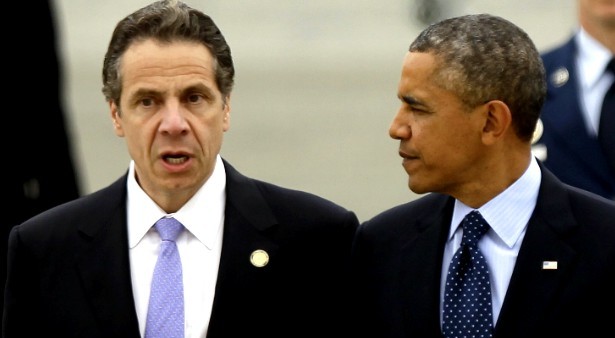
New York State Governor Andrew Cuomo, brother of CNN’s Chris Cuomo, with the President of the US
Haot “Secretly” Owns Inflammatory Ground Report
The shadowy founder and owner of the bitterly anti-Italian Ground Report “citizen journalism” website works for one of the most prominent Italian-Americans in the United States.
He is Andrew Cuomo, the very pro-Italy governor of the State of New York. Brother of Chris Cuomo who in his CNN TV persona has twice interviewed Amanda Knox, each time seemingly unconvinced and underwhelmed.
In contrast, for Rachel Sterne Haot it has been a case of rabid pedal-to-the-floor Knoxiana and rabid anti-Italian demonizing for the past few years to boost her anemic readership and to try to make a buck. Other website owners with better judgment had previously kicked off these dangerous crazies.
See very typical examples of false accusations of serious crimes by Italian officials here and here and here and here and here. If any media request this help, we can provide links or captures for 150+ more.
Pro-justice pro-Italy pro-Meredith points of view have been remorselessly edited out for nearly four years. Protests of defamation have been repeatedly brushed off with the claim that “a lawyer” who is never named says the defamation is just fine.
This new post below on Ground Report was by the (of course) anonymous “Jay Rap” and represents his sixth inflammatory and highly defamatory post in just three weeks.
Later in the Interrogation Hoax series, when we have finished laying out what really happened, we’ll take apart all such misleading and defamatory posts. May note be taken of them in Albany and Italy.
The Rudy Guede Hoax
Here’s a quick rebuttal of Jay Rap’s untethered rant about Rudy Guede, who will be the subject of a second hoax series soon. Prior to the attack on Meredith, police had no knowledge or written record of either Rudy Guede or Patrick.
Dr Mignini had never even heard of Guede till analysis days after the murder of his handprint surfaced who he was (Knox didn’t name Guede but carefully pointed at him, as this series of transcripts shows).
Guede did not ever work for the police. Guede did not ever get even one break in this case.
Milan police released him after he was found staying overnight in a Milan pre-school only because he had no prior record, not because anyone in Perugia told them to. In 2009 Guede offered to testify against RS and AK at trial in exchange for a break. HE WAS TURNED DOWN. No breaks at all.
“Knox Was Intentionally Framed By Italian Police”
Rachel Sterne Haot may wish to note that Jay Rap’s made-up accusations here go away beyond what already cost Amanda Knox three years. Everything shown here in bold (and more) is untrue. All of Jay Rap’s histrionic posts are pure fiction.
If you are following our Interrogation Hoax series, you will see immediately how wildly wrong this all is. If not, scroll down to “2. How Knox helped police with recap/summary”
Following up on the Italian police motive, this series will explore the positive indications that the Italian police intentionally framed Amanda Knox and Raffaelle Sollecito for the murder of Meredith Kercher. Here we review the pre-planned illegal interrogations of Amanda Knox and Raffaele Sollecito. This is a summary of a review here (link).
Again, the motivation for framing Knox and Sollecito is to deflect attention away from Rudy Guede in the killing of Meredith Kercher, so as to conceal the culpability of the Perugian authorities and Giuliano Mignini for having protected and thus enabled Guede to murder Meredith Kercher. In short, self preservation. (For a review of the Police motive for framing Amanda Knox for the murder of Meredith Kercher, please see this previous article (link), or a summary of that article here (link).
The first indication of intentional framing by the Italian police, is the text book characteristics of the intensive and regimented pre-plamnned program of interrogations that were conducted by the police, resulting in falsely incriminating statements from the defendants.
It should first be said, that no confession taken under any circumstance whatsoever, can overcome the overwhelming physical evidence that the murder of Meredith Kercher was committed only by Rudy Guede. The lack of any physical trace of anyone else in the tiny blood soaked room where Meredith was killed, renders it a scientific impossibility that anyone but Rudy Guede, and he alone, killed Meredith Kercher. There is no evidence of a “˜staged break-in’, that claim is simply a distraction from this basic and obvious truth. Having said that, let’s discuss the interrogation.
It is undisputed that in the five days from the discovery of the Kercher murder, to the arrest 5 days later, Amanda Knox was subjected to 43 hours of questioning by the Italian police. The last overnight session went from 10:30pm to 6am the next morning. We need look no further than Steve Moore’s analysis in his contribution to the book; “The Forgotten Killer; Rudy Guede and the Murder of Meredith Kercher”, to understand this process and objectives.
One of the most striking elements of Moore’s narrative, is the extraordinary degree of consistency between the program of interrogation applied against Amanda Knox and Raffaelle Sollecito by the Italian police, and that described in a declassified FBI manual discussing techniques for “brain washing” used by the communists in North Korea.
Moore, quoting the FBI the manual; “Deprivation of sleep results in more intense psychological debilitation than does any other method of engendering fatigue. The communists (North Koreans) vary their methods. “Conveyor belt” interrogation that last 50-60 hours will make almost any individual compromise, but there is danger that this will kill the victim. It is safer to conduct interrogations of 8-10 hours at night while forcing the prisoner to remain awake during the day. Additional interruptions in the remaining 2-3 hours of allotted sleep quickly reduce the most resilient individual.”
At 43 hours over 5 days, the Italian police interrogation of Amanda Knox is perfectly consistent with the formal brain washing techniques favored by the North Korean communist totalitarian regime. It is a clear violation of human rights in any civilized country operating under any recognizable rule of law.
Moore also draws special emphasis on the last day of the interrogation, the overnight session. Remarking on the number of detectives, he writes; “The fact that there were twelve detectives in the police station overnight is an indictment in and of itself. If you are going to have twelve detectives available all night for an interrogation, you need to let them know well in advance. You need to schedule them, to change their days off, etc. You need to pay them overtime. In the real world, twelve detectives all night is something that has to be signed-off on by higher ups. What does that tell us? It tells us the interrogation was planned well in advance and intentionally overnight.” (emphasis Moore).
That this process was pre-planned, is also suggested in Amanda Knox’s own account in her book, “Waiting To Be Heard”. When speaking with Rita Ficarra, whom Knox describes as “˜her main interrogator’ and has identified as the officer who twice struck her during the last crucial session, Knox had asked if she could leave Perugia to stay with her Aunt in Germany, and Ficarra’s response; “You can’t leave Perugia. You’re an important part of the investigation”. When Knox inquired how long she would be needed, Ficarra’s reply; We don’t know- maybe months”. When Knox responded that she was planning to go home for Christmas. Ficarra’s response; “We’ll decide if you can do that. We’ll have to hear what the magistrate says when he calls in three days”. This conversation occurred on the morning of November 3rd, the day after the crime was discovered. The decision to specifically target and frame Amanda Knox, was likely made no later than on the evening of November 2nd, 2007, the same evening of the day the crime was discovered.
Regarding the last overnight interrogation, Moore continues; “The reason they interrogated Amanda all night was to break her. Not to get the truth, not to get answers, not to make Perugia safer, but to break her so that she would say what they wanted her to say.”
Reflecting on the overall process, Moore adds; “Amanda Knox was interrogated for eight hours. Overnight. She was denied food and water. She was denied the use of a bathroom. In a police station. In a foreign country. In a foreign language. By a dozen different officers. Without being allowed a lawyer.”
Moore continuing; “The inquisition Amanda Knox endured in Perugia was no more legally or morally defensible than the Salem Witch Trials. No rational person should believe that the results of what she went through are reliable evidence. If you gave me the same amount of time with Knox’s prosecutor (Mignini), I could have made him confess to the crime.”
Moore’s contribution and the book itself are well worth the read for anyone wanting to understand the injustice of the case against Knox and Sollecito, but let’s turn lastly to Moore’s comments on why an interrogation stops.
Moore; “There are two reasons an interrogator stops an interrogation: 1. He/she gets what he/she wants, or 2. He/she gives up. If the interrogator gives up, there is no written statement by the suspect. Therefore if the interrogation ends with a signed statement, you know the interrogator got what he/she wanted and can easily determine what that was. And what did Amanda say that satisfied her inquisitors? “˜I confusedly remember seeing Patrick come out of Meredith’s room.’ So what did they want? They wanted to implicate Patrick Lumumba.”
Moore explains; “Amanda did not bring up the name of Patrick Lumumba. The police did. And they repeatedly told her to “˜imagine’ Patrick and herself being at the cottage that night. Amanda did not give in to the brainwashing. But the police achieved enough with her to obtain a statement that let them do what they had intended to do all along: arrest Patrick Lumumbra”
As has been said, the motive of the Italian police and Mignini was to defect attention away from Rudy Guede, but in any event, to absolutely deny that Rudy Guede acted alone. For that to be the case, the break-in had to be staged, because otherwise, its just Rudy all by himself breaking in, and killing Meredith Kercher.
But by embroiling multiple people in the crime, the police could if not keep Rudy out of the crime entirely, they could at least minimize his role. If Patrick Lumumba had remained as a defendant, no doubt all the judges would have put the knife in his hands. But since Rudy Guede could not be kept out of the picture, it became necessary for someone else to play a more dominant and leading role.
And of course such a person had to be someone capable of manipulating others, and who better for that role ““ in the mind of Mignini, than a seductive manipulative woman. So in the fantasy world of the Italian prosecutors, judges, police, and an unfortunately significant segment of the populations of Italy and the UK, the knife that killed Meredith Kercher ended up being placed in Amanda’s tiny hands, in their fantastic false imaginings.
Of all the lies that have been invented and repeated in this case, among the worst is that of those who misuse the confused statements that were extracted through psychological torture, as evidence of deception on the part of Amanda Knox and Raffaelle Solecito. It is the exact equivalent of blaming a rape victim for the consequences of a violent sexual assault. This lie is repeated by major news outlets, unscrupulous or careless reporters, and has become part of the lexicon of the case. It’s both tragic and profoundly unfair.
The cruelest and most criminal hypocrisy of Mignini, the Italian police and judiciary, is to blame Knox for the confused statements induced through these abusive coercive means. The Italian police charging Amanda Knox with Calumnia, after forcing her to name Lumumba as part of their process and their own objective, must surely be a violation of human rights that all civilized countries and people must deplore.
When Knox herself testified to the ordeal she was put through at trial in her own defense, she was further charged with calumnia against the police, a charge which the prosecution itself would be allowed to investigate, an obvious conflict of interest. In Italy, defending oneself against fraudulent charges by the prosecutor, is apparently a criminal act.
The criminal, brutal, illegal, and supposedly unrecorded interrogation by the Italian police should shock the conscience of the civilized world. Yet this criminal conduct by the Italian police must again be concealed by blaming the victim. Charging Knox with calumnia for being tortured into naming Lumumba, is the arrogance of unrepentant criminals. And it is a marvel to behold how pliant and cooperative the Italian, UK and international media have been in simply passing along the prosecution’s malicious self-serving slanders.
It may be the Italian authorities simply no longer have the ability to recognize the wrongfulness of their own behavior.
Knox’s final conviction for calumnia by the Italian Supreme Court of Cassation is being appealed to the European Court of Human Rights, where we must all hope this shameful miscarriage of justice will finally be corrected.
The last word is perhaps best left to Moore: “How could this happen? It is either inexperience combined with poor training or corruption ““ or both. I have had rookie FBI agents come out to the field and conduct vastly superior investigations to what happened in Perugia in this case. I do not think the Italian system is inferior. In fact, if I thought so, I would not be criticizing those detectives in this manner.”
Significantly, Moore concludes; “Every country has prosecutors and investigators who make mistakes. Every country experiences the shame of corruption. No country should be judged on whether these things exist; it should be judged on how it deals with them.”
When Patrick Lumumba was released, and Rudy Guede was brought back from Germany, Rudy was substituted in for Patrick in the prosecution’s case. But now the role of chief instigator would pass from Patrick, and be applied to Amanda Knox. Because from the perspective of the Perugians authorities, Mignini, the Italian police, and the Italian judiciary, Rudy Gude could not have acted alone (which is why the break-in must have been staged), or at worst, Rudy must have been a lesser player in this crime which was as has been stated, was by necessity a group effort in the prosecution’s theory ““ for otherwise, the Italians themselves are responsible for Meredith Kercher’s death.
Other commenters have said that the police erred by not changing their theory of accusation, when they slotted in Guede for Lumumba, that they suffered from “˜target fixation’ or other innocent mistakes. I disagree. There never was an “˜accusatory theory’ in the sense of one supported by evidence. The police objective of minimizing Guede’s role, and therefore their own culpability in the murder of Meredith Kercher, was intentional, premeditated, and ultimately unaffected by Guede’s formal emergence as a culprit. The Italian police objectives remained unchanged; under no circumstances, could Rudy Guede be found to have acted alone, because otherwise, Kercher’s killing was the fault of the Italians.
There has never been an investigation in the usual sense of the word. It has been an exercise from the beginning of intentionally framing two innocent people for crimes they had nothing to do with, to deflect attention and criticism away from Mignini and the Perugian authorities ““ and there is a clear conflict of interest in allowing the Perugians and the Italian judiciary, to investigate themselves.
And so, the frame-up proceeded accordingly.
With Amanda’s and Raffaelle’s coerced statements in hand, now all that was necessary for Mignini and the Perugians, was to fabricate the evidence, and build their “˜case’.
Below: the eager host to the dangerous Knox crazies Rachel Sterne Haot
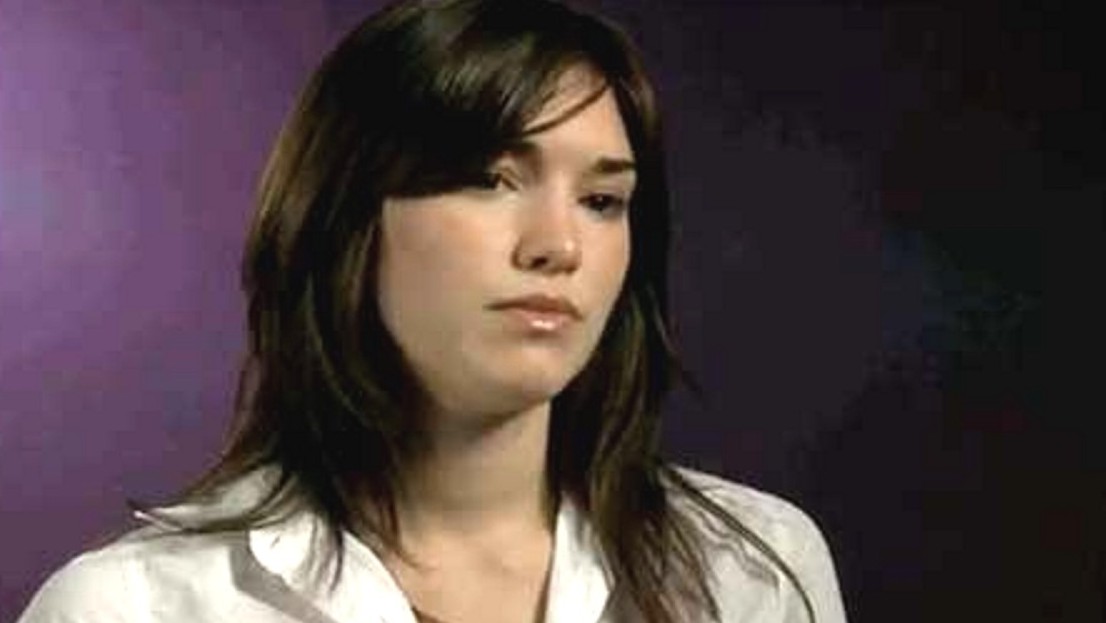
Thursday, April 03, 2014
Sleazy Magazine Trick To Sell More Copies Results In Angry Reaction In Germany
Posted by Peter Quennell

[Cover of German magazine Aktuelle; the banner headline translates as “Awake!”]
As we have seen, bad reporting can cause real harm. Here is an encouraging example of other media hammering the originator of a hurtful, tacky reeport.
The German Grand Prix driver Michael Schumacher, the winningest of all time, is a huge hero in Germany, and known and liked throughout the world. He amassed a fortune close to $1 billion and had started many projects with his money to make a difference to many peoples’ lives.
The 44-year-old retired driver who is currently fighting for his life in a Grenoble hospital following a skiing accident has long made large but low-key donations around the world. Here are some examples from the NewsTalk site.
UNESCO
The former Ferrari driver is a Special Envoy for Education and Sport and donated €1.5 million to the organization.
In a 2002 interview with the organization he explained his dedication to funding projects: “I really want to help the ones people don’t know about. Nowadays, certain projects attract lots of donors. Then there are others you never hear about. Those are the ones I’m interested in.”
He also once told F1 magazine that: “It’s great if you can use your fame and the power your fame gives you to draw attention to things that really matter.”
SenegalIn 2002, Schumacher funded the construction of a school in a poor slum in Dakar, the capital of the West African state of Senegal.
Sarajevo
In 1997, Schumacher opened a clinic for child victims of the Balkans War. The clinic provides artificial limbs for amputees as well as psychological support.
PeruIn 2002, he funded the construction of a ‘Palace for the Poor’ in Lima, Peru which caters for homeless children and provides education, food and medical treatment for street children.
2004 TsunamiAlong with his two sons, Schumacher’s bodyguard lost his life in ihe 2004 Tsunami following the Indian Ocean earthquake. Schumi donated over €7 million in aid which meant that he gave more money than many individual countries, sports entities and organizations. .
Schumacher has remained in a coma in a French hospital for three months since a ski accident which initially seemed minor led to bleeding in the area of his brain. This is a particularly difficult time because for some weeks doctors have been trying to wake him up.
There is an unprecedented number of ongoing tributes to Michael Schumacher by friends and fans around the world and all the Grand Prix cars at present are carrying a message of hope.
A majority of brain surgeons now feel his waking-up will be a long shot at best, but Schumacher’s very loyal wife Corinna is having a $10 million medical facility built in a hurry at his estate several miles north of Geneva, Switzerland, on the west side of the lake. [Though widely reported his manager has just denied this.]
What has caused the outrage in Germany is the banner headline on the cover of a women’s magazine saying “Awake” implying that Schumacher himself has woken up. From the Eurosport site:
Outraged Michael Schumacher supporters have bombarded a magazine with furious complaints after a front page showed the F1 legend smiling with a horribly misleading headline - ‘AWAKE!’.
The magazine’s content, which was actually full of stories about other people who had woken from comas has infuriated Schumacher fans, who saw the smiling photo of the star cuddling wife Corinna as “abysmal”, “tasteless” and “insulting”....
Dr Gerd Hartmann, a regular reader, wrote in the comments section of popular news portal News.de: “Such magazines are simply terrible, especially given that the chances of survival with this type of therapy are abysmal.
“Out of 10 patients 5 would never recover, 3 will be severely disabled and only 2 might recover.”
Another user, posting under the name SchumiFan, added: “I can’t believe they are cashing in on this tragedy - there should be a law against this type of shoddy, sensationalist and downright insulting journalism.”
Meanwhile, German media ethics expert Christian Schicha said: “This is a clear attempt to deceive the readers. It is an obvious attempt to make money out of a sick man.
“It is completely tasteless. It is ethically completely out of the question. “Die Aktuelle blatantly makes the impression through the headline that they know something new about the case. It is completely irresponsible.
“Schumacher’s family have suffered enough without this kind of story circulating.”
Another cruel media trick of the kind that hurts the victim’s family the worst.
[Below: Schumacher and his wife Corinna were legendary for being together at every possible moment ]


Thursday, January 02, 2014
“Popular Forensic Crime Writer Says AK Is Innocent” But Misconstrues Evidence Pointing To Guilt
Posted by FinnMacCool
That headline above is from a KOMONews report on Patricia Cornwell’s take on the case about seven weeks ago.
On her promotional tour for her latest novel (see the video above) Patricia Cornwell made the following comments about the pursuit of truth: “If you stumble upon a truth, I don’t know what case it is, maybe this is the old journalist in me, I feel I am obligated to say something about it…”
Many of us can sympathize with those words, particularly readers of a website devoted to securing justice for a young woman who was brutally murdered in 2007. Cornwell went on to make reference to this very case, bringing some of her own experience to bear as regards time of death:
One of the things that has frustrated me about [the Meredith Kercher case], they’ve made a great big deal about the victim’s stomach contents and how they placed the death at a certain time because her food had not really digested all that much.
It’s like, ‘Hello, when you go into flight or fight mode, your digestion either shuts down completely or at least it slows, because all the blood is going to your extremities so you can defend yourself or run.’ And if somebody is being assaulted, their digestion quits.
I’ve seen it in the morgue where somebody who ate 8-10 hours earlier - their food is exactly as they swallowed it.
Cornwell may be a talented writer, but she shows herself here to be a less than careful reader, because the point she makes here supports the prosecution case, and it undermines that of the defense.
It was of course the Knox/Sollecito defense teams who claimed that the victim’s stomach contents placed her death at an earlier time (to a point close to when their clients still had an alibi), while the prosecution successfully argued along the same lines as Patricia Cornwell, that stomach contents cannot be used to establish time of death with such precision.
Here is the way Knox herself describes the defense position in her memoir Waiting To Be Heard:
Meredith had been murdered by 10 P.M., based on her stomach contents, but the prosecutors invented a scenario in which Meredith was home alone between 9:30 P.M. and 11:30 P.M. According to their argument, the sphincter between the stomach and the small intestine tightens at the moment of trauma, and digestion temporarily stops. (WTBH: 222)
In other words, Patricia Cornwell’s expertise in this area leads her to agree with the prosecution’s argument, and undermines the case of the defense. Nevertheless, Cornwell claims to have followed the case closely, and to be of the opinion that Knox and Sollecito are innocent, with Rudy Guede the lone sexual predator.
The PR firm hired by Amanda Knox’s family (Gogarty-Marriott) will be pleased that such a high profile commentator has reached that conclusion, but they will also be hoping that people just read the headline quoted above, without looking too closely at the contradictory substance of Cornwell’s remarks.
Courts of law look at evidence; courts of public opinion listen to soundbites.
In the Meredith Kercher case, a succession of courts (with one annulled exception to date) have found, just as Patricia Cornwell’s experience suggests, that the bulk of the evidence in this case supports a guilty verdict for all three defendants.
Patricia Cornwell claims to care about truth and justice, and to support the rights of victims to have their stories told. It would be an honorable move on her part, then, to correct the impression given by her recent interview that her expertise supports the defense case rather than that of the prosecution. As Cornwell herself puts it:
The truth should never be hidden, particularly in heinous crimes. It’s never too late for it to come out even if we can’t prosecute anybody for it any more. We owe it to those who were brutalized, or assassinated, to tell the true story about what really happened.
She is of course far from the first expert to be misled by cherrypicked “facts”. See for example here.
Thursday, November 07, 2013
Another Highly Misleading Associated Press Report By Colleen Barry Appears on 700 Media Websites
Posted by Our Main Posters
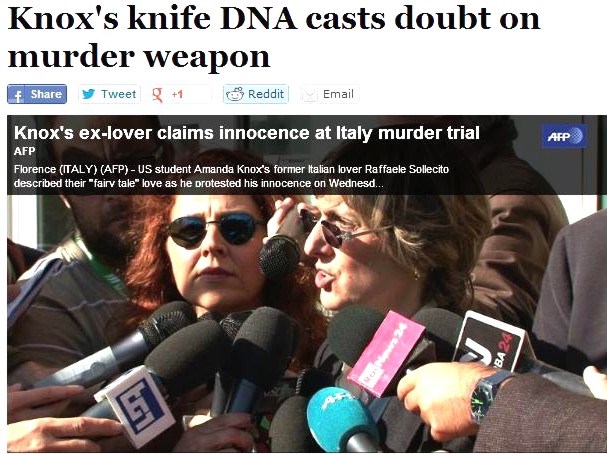
{Above: the AP headline. At bottom: the AP reporter, Colleen Barry; will she correct the report?]
Read here what Colleen Barry of the Associated Press (image below) falsely claims.
How exactly does a second proven DNA trace of Amanda Knox on the knife prove that Meredith’s proven DNA on the knife wasn’t there? The correct facts on the three DNA samples were posted here.
Nothing - nothing - that was said yesterday in court affected that. Two samples of Knox and one sample of Meredith on the knife are confirmed. All three are there.
In fact, Judge Nencini leaned hard on the bumbling Amanda Knox lawyer Dalla Vedova to make him stop. Dalla Vedova was repeatedly trying to trap the Carabinieri experts Dr Barni and Dr Berti into saying that Dr Stefanoni did something wrong in her test of Meredith’s DNA. Judge Nencini had not even instructed the Carabinieri labs to look into that.
Dalla Vedova and Colleen Barry of the AP have apparently forgotten that defense observers were there at the Scientific Police labs test and testified that they saw Dr Stefanoni do nothing wrong. Dr. Renato Biondo, Professor Giuesppe Novelli, Professor Francesca Torricelli, Luciano Garofano, Elizabeth Johnson and Greg Hampikian all confirmed that Meredith’s DNA was indeed found on the blade of the knife..
Judge Nencini clearly believes that firm evidence of Meredith’s DNA is there in front of his court, and that Dr Stefanoni and Judge Massei got it right. Meredith’s DNA really was proven to be on the knife. He would not allow a clumsy red-herring argument from Dalla Vedova which lacked the slightest bit of proof.
Unlike Reuters, the Associated Press is not a public company. It issues no stock.
It is instead a co-operative jointly owned by about 1000 media groups, and its reports are carried on up to 1000 sites. It is financially not very well off, and many of its media owners are in the same boat. The AP and many of its owners are increasingly cutting corners to save a buck. Increasingly they are under-researching, failing to check, and so their viewers and their readers are ending up misled.
Does financial strain excuse the AP for hyperbole and seriously wrong claims, for reprinting of false public relations handouts and false lawyer claims as hard fact? As it has too often done before?
Would it not be better when facts are in doubt and justice on the line to not report at all?
{Below: Colleen Barry of AP Germany was the writer of the misleading piece]
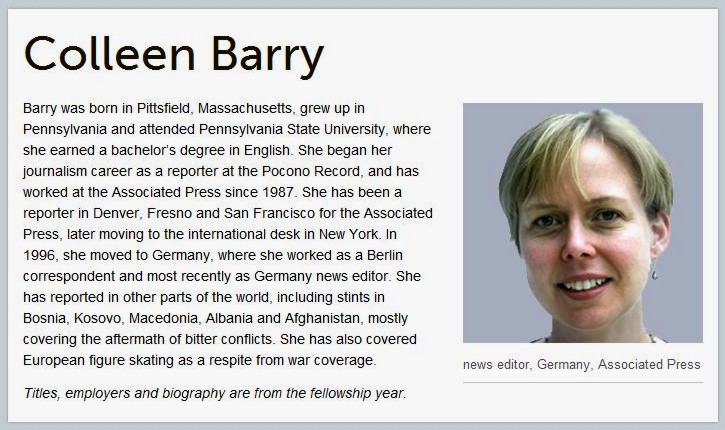
Thursday, May 17, 2012
Lord Justice Leveson: In Fact MANY Press Errors Were Made In The Reporting On Meredith’s Case
Posted by Peter Quennell
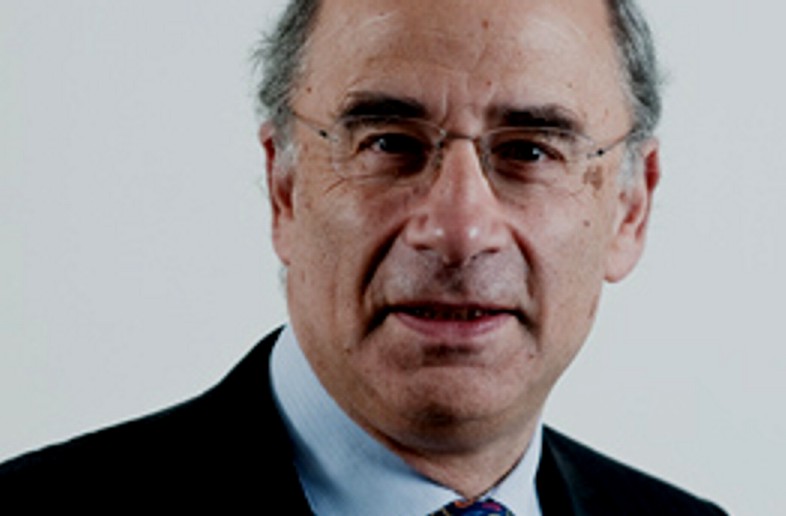
The enquiry in London by Lord Leveson (above) is looking into press phone hacking and extreme coziness with politicians and police.
A few days ago, Lord Leveson’s lead lawyer grilled Martin Clarke, the Mail Online’s editor, about a story that briefly showed on the Mail Online website last October. It stated that the Hellman appeal court had confirmed that Knox was guilty.
Actually neither Martin Clark nor Lord Leveson’s lead counsel got it right - nor for that matter any other media in the UK. Judge Hellman had simply issued another INTERIM and PROVISIONAL verdict not yet ratified by the Supreme Court.
Under the Italian justice system, Amanda Knox and Raffaele Sollecito STILL stand accused of the crime, until the Supreme Court finally signs off. There is a very strong prosecution appeal now in front of the Supreme Court, and Judge Hellman’s not-guilty verdict will very likely be reversed.
As this has rarely if ever been correctly reported in the UK almost every interested British observer now has it seriously wrong. Take a look here at how the BBC got it wrong at great and effusive length.
It starts with this: “For one family from Seattle, a four-year nightmare is over….” The BBC didn’t even mention the four-year nightmare of Meredith’s family.
The myriad wrong facts in that BBC report were not simply technical mistakes on the same lines as the Mail Online’s. They were talking reports supplied by Curt Knox’s abusive and misleading PR campaign which the BBC then parroted in a pandering and highly unprofessional report. One revealing zero attempt at checking or balance.
Which, really was worse? A technical mistake by the Mail or a deliberate selling-out by the BBC?
As Mr Clarke observed on the stand, this is not an easy case for UK media to report. But newspapers and TV networks and their websites carrying resident reporters Andrea Vogt and Barbie Nadeau and the ABC’s Anne Wise (now yanked persumably for being too honest) and Richard Owens and John Follain of Rupert Murdoch’s London Times group always manage to get it right. So for the most part does the the freelance Nick Pisa who we also often quote.
In contrast the erratic Nick Squires and the erratic Michael Day of respectively the Telegraph and the Independent just two weeks ago reported very misleadingly - and no correction and apology has yet appeared.
If the Leveson enquiry wants to explore DELIBERATE media mistakes we have highlighted dozens on this site.
Tuesday, March 27, 2012
Dear CEO Gary Pruitt: Could The Associated Press Try To Report Right A Little Harder?
Posted by Peter Quennell

The New York-based Associated Press (headquarters shown at bottom) bills itself as the world’s oldest and largest news-gathering organization.
[From the AP website] More than one billion people look to The Associated Press (AP) for news each day. Founded in 1848, the AP is the world’s foremost information resource with more than 3,700 employees at 242 bureaus worldwide serving 121 countries 24 hours a day, seven days a week via newspaper, radio, television and the Web.
The AP is a co-operative owned by over 1,000 newspapers and, like most of the mainstream media it serves, the AP rather has its back against the wall. From the Wikipedia entry:
The AP lost $14.7 million in 2010 as revenue plummeted for a second consecutive year. 2010 revenue totaled $631 million, a decline of 7% from the previous year. This is despite sweeping price cuts designed to bolster revenues and help newspapers and broadcasters cope with declining revenue.
That image above is of Gary Pruitt. A lot is riding on him to sustain a quality service and deversify in any way he can to pump those revenues back up. Right now, he is a senior media executive in Sacramento, California, but he will become the president and CEO of the AP in two months.
Most Americans hear far more about Meredith’s case from the AP than they do from any other source. Typically the AP sends out a story every few days when the case is live in Perugia. Typically these stories then get posted on 200 to 2,000-pus media websites in the US and around the world.
The AP also sends out many video reports, which are broadcast by the many member TV stations, and the AP also posts them on YouTube. If you search Google Video for “associated press meredith kercher” you will get 30,000 hits, and if you search “associated press amanda knox” you will get ten times that amount.
The AP reports on the case have at times veered to the deeply trivial. Here is a post about Amanda Knox’s 2008 Christmas in prison which included only a single sentence about the real victim Meredith and her family. Within hours it was up on 800 websites.
The AP reports have also at times included seriously wrong facts. Sometimes it corrects them, sometimes not. Here is a post about a correction of a mistake which appeared on about 2,000 websites. The apology has been removed but the story when posted was inaccurate and it has been re-written to hide that. .
But the real gut problem in AP reporting on the case is one of deep superficiality and of leaving an awful lot unsaid.
Here is a report by the AP cultural and publishing correspondent Hillel Italie (image below) in New York. It is essentially correct so far as it goes, but it is a good example of the republishing of press releases while leaving an awful lot unsaid.
Here are just three examples of what the AP could have covered in this report and its many other reports but so far hasn’t.
- All trials and appeals have concluded with a sentencing report in Italian explaining what the reasons of the judges were. The AP has not only done no translation (it has bilingual reporters in Italy); of the reports’ very existence, the AP audience would never know.
- There is a lot of legal activity just ahead in the Supreme Court appeal against RS and AK and the calunnia and perversion of justice trials. The once-convicted perps are now looking at a formidable new prosecutor, though the AP audience would never know.
- There has been a costly, huge and highly onesided PR effort which has been unfairly hard on Italy and its justice system and its police and prosecutors and experts, to the point often of defamation, but the AP audience would never know.
Anyone who gets their news on the case only from the AP would essentially know NOTHING of the facts we have advanced in all the recent posts on the books and shortly before that in all the recent facts on the appeal and family trials. They would know only a tiny fraction of the full universe of facts and much of what they do “know” is flat-out wrong.
Nice going, Associated Press. Your worst performance ever, perhaps? But then, why bother, when only an entire very civilized country and hundreds of its officials and truth and justice are being slimed?
What most Italians know of the details of the case is maybe ten times more detailed and comprehensive and fair and accurate than what most Americans and many Brits know. Italian reporting and interviews and media investigations are very fair. In contrast the AP is proving lazy and sloppy and inaccurate. Not to mention very dishonest.
Mr Pruitt, please ensure that AP reporting learns something from this? Right now, they are falling seriously short.
[Below: the Associated Press cultural and publishing reporter Hillel Italie in New York]
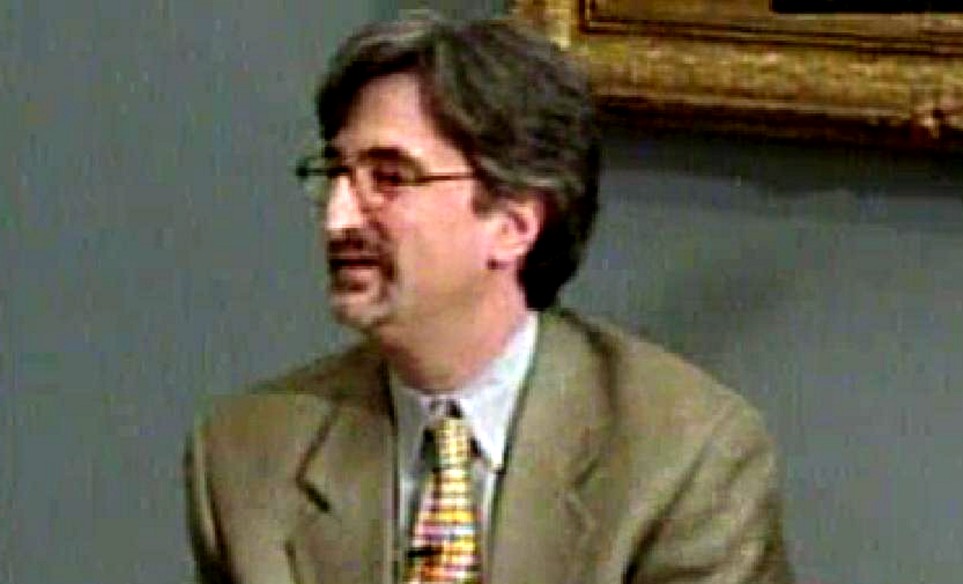
[Below: part of the main AP press room located on 33rd Street on the west side of Manhattan]

[Below: the AP occupies space in that large square dark building immediately behind the Hudson Rail Yards]

Sunday, July 03, 2011
A Deeply Ugly, Inaccurate And Callous Piece Of Junk By Nathaniel Rich In “Rolling Stone”
Posted by The Machine
According to Wikipedia, Nathanial Rich is an American author and essayist.
He is also the son of the New York Times columnist Frank Rich, and various online commentaries about him credit that.and not talent or ethics or hard work for any success he might have had.
Still, you would think that being the son of a high-profile journalist, Nathaniel Rich would try hard to write a fair, factually accurate and balanced report. One carefully checked out, with the Italians he impugns and with no sign of obsessive pro-female-perp bias.
But instead Nathaniel Rich and his editor Sean Woods (image below) have come out with an xenophobic, defamatory, highly inaccurate report..
In this piece Rich comes across like the notorious Stephen Glass who simply made stories up and whose editors never cross-checked until it was too late. Except Stephen Glass that never actually showed bigotry or defamed.
It does not seem too much to ask to expect anybody writing an article about the shocking sexual assault, torture and murder of Meredith Kercher for them to have done their due diligence? And to made sure that every single claim presented has been verified by the official court documents or independently corroborated by objective and reliable sources?
And for Sean Woods and other New York-based Rolling Stone editors even in their decline to check out their writers’ claims, especially with those impugned?
In this piece we analyze just some of the numerous wrong claims by Nathaniel Rich in his article The Neverending Nightmare of Amanda Knox and compare them (as he should have done) to official court documents such as the Micheli report, the Massei report, Rudy Guede’s final sentencing report by the Supreme Court, and testimony at 2009 trial and 2011 first appeal [later annulled].
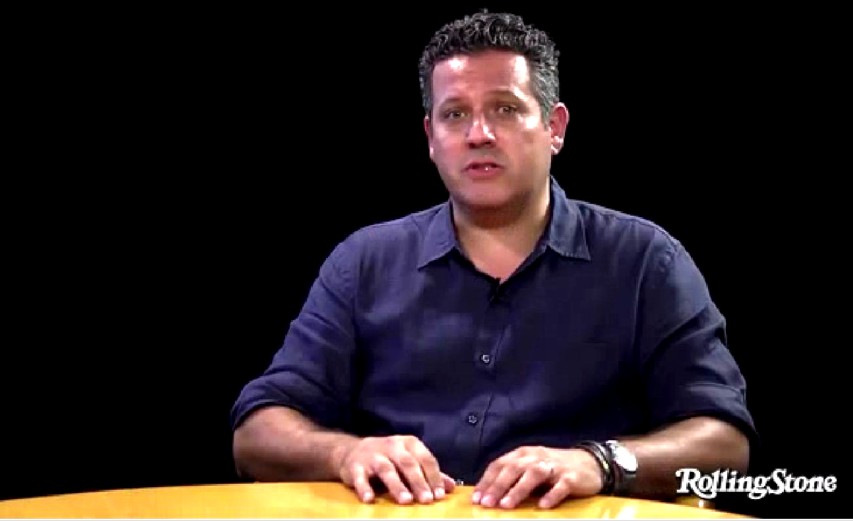
Above: Nathaniel Rich’s editor at Rolling Stone Sean Woods
Claim 1: There were bloody fingerprints all over the apartment
Wrong. Nathanial Rich gets his first basic fact wrong in just the second sentence of his article with his claim that Guede left bloody fingerprints all over the apartment.
There was in fact not even one. According to the Micheli report, the Massei report and Rudy Guede’s final sentencing report, Guede was identified by a single bloody palm print, not a whole lot of bloody fingerprints:
b) traces attributable to Guede: a palm print in blood found on the pillow case of a pillow lying under the victim’s body ““ attributed with absolute certainty to the defendant by its correspondence to papillary ridges as well as 16-17 characteristic points equal in shape and position… (page 5, Rudy Guede’s final sentencing report).
It is confirmed that Guede was identified by a bloody palm print in the Micheli report (pages 10-11) and the Massei report (page 43). There was not a single fingerprint of his or Sollecito and almost none of Knox at the crime scene - which consists of the entire apartment.
Rich’s “her killer” in his opening implies there was only one killer but FOUR courts including the Supreme Court insisted there had to have been three. The lone wolf theory has long been dead. This is why the defense had to drag Alessi and Aviello into court two weeks ago, to try to prove Knox and Sollecito were not the other two.
Claim 2: A provincial police force botched one of the most intensely observed criminal investigations in Italy’s history
Wrong. A Knox cult myth. Nathaniel Rich attempts to disparage the investigation in Meredith’s murder with the smearing claim that it was seriously botched (it wasn’t) and by a provincial police force. Nathaniel Rich is trying to insinuate that that the police officers involved in the investigation were unsophisticated. However, again he only succeeds in revealing his ignorance of even the most basic facts of the case.
Two separate police departments from the Italian equivalent of the FBI in Rome were heavily involved in the investigation into Meredith’s murder: a forensic team from the Scientific Police led by Dr. Stefanoni, and the Violent Crimes Unit, led by Edgardo Giobbi.
Claim 3: Sollecito finally stated that Knox could have left his apartment for several hours on the night of Kercher’s murder while he was asleep
Wrong. Nathaniel Rich’s claim that Sollecito said that Knox “could” have left his apartment for several hours while he was sleeping is simply not true. You can read Sollecito’s various alibis here. Sollecito categorically stated in his witness statement that Knox DID leave his apartment, while he was wide awake. He said she went to Le Chic at 9:00pm and she came back at about 1.00am.
“At 9pm I went home alone and Amanda said that she was going to Le Chic because she wanted to meet some friends. We said goodbye. I went home, I rolled myself a spliff and made some dinner.”(Aislinn Simpson, The Daily Telegraph, 7 November 2007
“Police said Raffaele Sollecito had continued to claim he was not present on the evening of the murder. He said: “I went home, smoked a joint, and had dinner, but I don’t remember what I ate. At around eleven my father phoned me on the house phone. I remember Amanda wasn’t back yet. I surfed on the Internet for a couple of hours after my father’s phone call and I stopped only when Amanda came back, about one in the morning I think.” (The Times, 7 November 2007).
So Sollecito never said Knox “could” have left his apartment “while he was asleep”. The source for Nathaniel Rich’s embarrassing factual error is almost certainly the conspiracy theorist Bruce Fisher, who has repeatedly made the same false claim on his conspiracy website, a site riddled with invented claims.
Shame on Nathaniel Rich for gullibly believing another Knox cult myth, propagated by the likes of Moore and Fisher, and for being too lazy to independently verify this information.
Claim 4: Amanda Knox was slapped on the back of the head
Wrong. Another Knox cult myth. Nathaniel Rich employs the same tactic as the conspiracists Bruce Fisher and Steve Moore who are trying by all possible means to rescue Amanda Knox from those dastardly Italians.
Namely, to give what appears to be a very detailed eyewitness account of what happened at the police station on 5 November 2007 despite the fact he wasn’t even there. He makes all of this up, including “verbatim” quotes from some unnamed police officers.
Two female officers, who had been chatting informally with Knox, invited her to an interrogation chamber.
“Let’s go back over what you did that night,” they asked her. “Start with the last time that you saw Meredith.”
“Again?”
“Again.”
But they went slower this time.
“What did you do between 7 and 8 p.m.?” they asked. “What about between 8 and 9?”
“I don’t know the exact times,” said Knox. “But I know the general series of events. I checked my e-mail, I read a book, we watched a film, we ate dinner….”
More officers kept entering the room. An interpreter showed up. The tone sharpened.
“But Raffaele says that you left his house that night.”
“What? That’s not true. I was at his apartment all night.”
The interrogators became angry.
“Are you sure? Raffaele said you left his house.”
“I didn’t.”
“If that’s a lie, we can throw you in jail for 30 years.”
“I’m not lying.”
“Who are you trying to protect? Who were you with? Who was it? Who was it?”
This bit went on for hours.
There was now chaos in the room. The Italians were shouting at her, arguing with one another, calling out suggestions.
“Maybe she really can’t remember.”
“Maybe she’s a stupid liar.”
“You’re either an incredibly stupid liar,” said Knox’s translator, who was sitting right beside her, “or you’re someone who can’t remember what you know and what you did.” The translator, changing tactics, explained that she had once been in a gruesome car accident in which she broke her leg. The event was so traumatic that she suffered amnesia.
“Amanda,” said the translator, “this is what happened to you. You need to try to retrieve those memories. We’ll help you.”
Knox, ever-credulous, started to ask herself what she might have forgotten.
“C’mon,” said the interrogators. “You were going to meet Patrick that night.” “Remember. Remember. Remember.”
“We know it was him.”
Knox shook her head.
“Remember.”
Boom “” someone slapped her on the back of the head.
So Nathaniel Rich includes the false claim that Knox was slapped on the back of the head. All the witnesses who were present when she was questioned, including her interpreter, testified under oath at trial in 2009 that Amanda Knox was NOT hit even once.
Even Amanda Knox’s lawyer, Luciano Ghirga, confirmed that Amanda Knox had not been hit: “There were pressures from the police, but we never said she was hit.” He never ever lodged an official complaint.
Nathaniel Rich should have pointed out that Knox claimed this hitting only long after, when she was trying to explain why she had framed Patrick Lumumba. He should not have repeated it as if it were incontrovertible truth.
And he should have pointed out that both Amanda Knox herself and both her parents are enmeshed in separate trials for doing that.
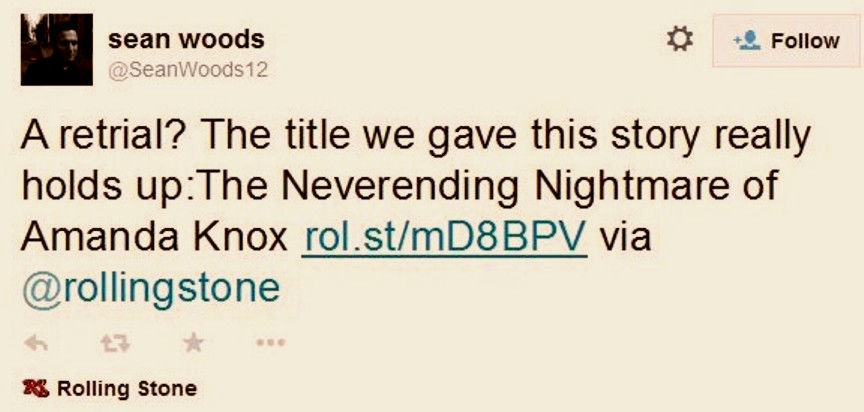
Above: Rolling Stone aggravates defamation - this tweet was sent March 2013
Claim 5: Amanda Knox finally broke down and accused Diya Lumumba of murder at 5.45am
Wrong. Nathaniel Rich clearly does not know the chronology of events at the police station on 5 November 2007. His false claim that Knox finally broke down at 5.45am gives the impression that she had been subjected to a continuous all-night interrogation.
In fact Amanda Knox very rapidly “broke down” and claimed that Lumumba was “bad” and had murdered Meredith when she was still only a witness, not a suspect, and was told Sollecito had pulled the rug from under her alibi. She signed a statement at 1.45am, not at 5.45am, when she repeated the claim voluntarily. (She also repeated it later that same day in writing.)
Amanda Knox’s questioning was stopped at 1.45am when she became a suspect. She wasn’t actively questioned again that evening. However, several hours later she decided to make an unsolicited spontaneous declaration. Mignini was called at 3.30am and he observed her declaration. Knox makes it explicit in her witness statement that she was making her statement spontaneously:
“I wish to relate spontaneously what happened because these events have deeply bothered me and I am really afraid of Patrick, the African boy who owns the pub called “Le Chic” located in Via Alessi where I work periodically.” (Amanda Knox’s 5.45am witness statement).
Claim 6: The knife was selected at random by a detective from Sollecito’s kitchen drawer
Wrong. Nathaniel Rich regurgitates another prevalent Knox-cult myth with his claim that the double DNA knife was selected purely at random. However, the person who actually selected the knife, Armando Finzi, testified in court that he chose the knife because it was the only one compatible with the wound as it had been described to him.
“It was the first knife I saw,” he said. When pressed on cross-examination, said his “investigative intuition” led him to believe it was the murder weapon because it was compatible with the wound as it had been described to him. (Seattle PI,
Claim 7: The confession, in violation of Italian police policy, was not recorded
Wrong. Another Knox cult myth. The police weren’t required to record Amanda Knox’s interrogation on 5 November 2007 because she was being questioned as a witness and not as a suspect. Mignini explained that Amanda Knox was being questioned as a witness in his letter to reporter Linda Byron:
“In the same way, Knox was first heard by the police as a witness, but when some essential elements of her involvement with the murder surfaced, the police suspended the interview, according to Article 63 of the penal proceedings code.”
She came in to the central police station voluntarily and unasked that night when Sollecito was summoned for questioning, and police merely asked her if she could also be questioned as a witness. She did not have to agree, but she did. No recording of witnesses is required, either in Italy or the United States.
Claim 8: Amanda Knox refused to leave Perugia
Wrong. This Knox cult myth is actually contradicted by Amanda Knox herself. In the e-mail she wrote to her friends in Seattle on 4 November 2007 she said she was not allowed to leave.
“i then bought some underwear because as it turns out i wont be able to leave italy for a while as well as enter my house”
Knox actually knew on 2 November 2007 that she couldn’t leave Italy. Amy Frost reported the following conversation.
“ I remember having heard Amanda speaking on the phone, I think that she was talking to a member of her family, and I heard her say, No, they won’t let me go home, I can’t catch that flight’” (The Massei report, page 37).

Above: Rolling Stone aggravates defamation - this tweet was sent September 2013
Claim 9: Mignini suggested that the victim had been slaughtered during a satanic ritual
Wrong. Another Knox cult myth. He did no such thing. Mignini has never claimed that Meredith was slaughtered during a satanic or sacrificial ritual, and that’s the reason why neither Nathaniel Rich - or anybody else for that matter - has been able to provide a verbatim quote from Mignini.
Mignini specifically denied claiming that Meredith was killed in a sacrificial rite, in his letter to the Seattle reporter Linda Byron:
“On the “sacrificial rite” question, I have never said that Meredith Kercher was the victim of a “sacrificial rite”.
Mignini also made it quite clear that he has never claimed that Meredith was killed as part of a satanic rite in his interview with Drew Griffin on CNN:
1’03” CNN: You’ve never said that Meredith’s death was a satanic rite?
1’08” Mignini: I have never said that. I have never understood who has and continues to say that. I read, there was a reporter ““ I don’t know his name, I mention it because I noticed it ““ who continues to repeat this claim that, perhaps, knowing full well that it’s not like that.
I have never said that there might have been a satanic rite. I’ve never said it, so I would like to know who made it up.
In fact Mignini has zero history of originating satanic-sect claims despite Doug Preston’s shrill claims. The notion of a secret satanic sect in Florence goes way back into history and many had declared the Monster of Florence murders satanic because of the nature of the mutilation long before Mignini assumed a (minor) role.
Claim 10: Mignini referred to Knox as a sex-and-drug-crazed “she-devil”
Wrong. Another laughable wrong fact. It wasn’t Mignini who called Amanda Knox a “she-devil”, it was Carlo Pacelli, the lawyer who represents Diya Lumumba, at the trial in 2009.
Carlo Pacelli’s comments were widely reported by numerous journalists who were present in the courtroom. Barbie Nadeau describes the moment he referred to Knox as a she-devil in some detail in Angel Face:
“Who is the real Amanda Knox?” he asks, pounding his fist in the table. “Is she the one we see before us here, all angelic? Or is really a she-devil focused on sex, drugs, and alcohol, living life on the edge?”
“She is the luciferina-she devil.” (Barbie Nadeau, Angel Face, page 124).
Conclusion
Nathaniel Rich has published a sloppy callous error-ridden piece of pure propaganda straight out of the Knox cult handbook, complete with a gushy fawning reference to Amanda Knox in the title.
The piece includes an inflammatory mischaracterization of the extreme caution of the Italian justice system and the various officials working on the case.
There is no mention at all of the never-ending nightmare of Meredith’s family or the fact that she is NEVER coming back. Rich doesn’t seem to have the requisite emotional intelligence or reporter skills to realise that he may have been duped and used by the money-grubbers and killer-groupies of the Knox-cult campaign.
Tuesday, June 28, 2011
Not For The First Time Has Zombie-Like Behavior Afflicted American Crime Reporting
Posted by Peter Quennell
[Comedy Channel’s Jon Stewart commenting on the media’s role in the Duke Lacrosse framing case 12 April 2007]
The headline yesterday on the NY Times’s Perugia reporting: “Appeal Trial Of Amanda Knox Opens In Italy”.
You can see the image in one of yesterday’s posts. Believe it or not the paper version of the NY Times today includes the exact same headline. We have been getting the NY Times delivered for over 20 years and swear by most of the reporting.
For some reason its crime reporting really sucks.
The Times’s poor crime reporting is a direct cause of my knowing about Meredith. I was following another gladiator battle between one solitary blog and a lot of ranting media, the NY Times included, over accusations of group rape by the male lacrosse team at Duke University.
Nearly a year after it was obvious that the woman and the prosecutor were framing the team, the NY Times STILL took the position that there was strong cause - that they were really guilty. The trial would simply rubber-stamp this.
Other media followed the NY Times’s lead in this, as they often do in the US. See above. This caused untold havoc in the lives of the boys and untold millions in legal fees and the boys will have a cloud over them for life.
Commenters on that blog (Durham in Wonderland) said maybe the same thing was going on here - maybe in Meredith’s case there was a media rush to judgment that Knox and Sollecito were being framed.
The NY Times has never ever published a kind word about Meredith or her family or supported the Italian authorities in their unenviable task. The only examples of reports that we point to of the NY Times are truly mischievous and contemptible. Take a look at these for example.
How The New York Times Caused Unneccesary And Unhelpful Anger In Italy
The Second Misleading New York Times Comment On The Case
Had the NY Times said the case is in order as it should have done 18 months ago the wild pro-Knox ride of the rest of the American media would have been cut off at the ankles. The NY Times allowed the mishievous floodgates to open.
Friday, June 24, 2011
Rachel Sterne’s Ground Report: Anonymous Editors, Anonymous Posters, Now Anonymous Lawyers Too? DRAFT
Posted by Peter Quennell
As they say here in New York: Gimme a break! What a bunch of wussies and wimps.
Yesterday I posted on TJMk about the group blog “Ground Report” which seems to have stupidly lashed itself to the hairbrained rants and libels of “Bruce Fisher” to keep itself alive.
Its reader numbers have tanked ever since.
In messages starting last sunday night I had simply asked the anonymous editors of Ground Report to remove “Bruce Fishers” anonymous libels about extortion and stalking and on and on. I thought it nice to write to them myself as we are all in the business of group blogs.
I explained the whole background to the libels at length.
Initially the anonymous editors were very friendly and co-operative and they kindly removed the libelous posts. They told me they were volunteers, and they said Ground Report might from now on stay away from Meredith’s case as it is such a factual and legal minefield.
But daffier instincts seem to have prevailed and last night they posted this:
We are pleased to announce that after our request two weeks ago for a volunteer attorney; one of the most prominent lawyers in New York City has stepped forward and offered pro bono counsel for GroundReport. He began his work this week and did discovery on a First Amendment issue involving one of GR’s citizen journalists who was challenging a powerful advocacy group regarding a controversial topic in the news. The attorney resolved the issue with a few phone calls to the “˜opposing’ counsel. The issue was resolved in GR’s favor due to the “plaintiff’s” misrepresentation of his relationship with the “˜opposing’ counsel. We are thrilled to have this resource available to us on matters of First Amendment rights and now have a person who can defend our reporters from harassment and attempts to silence their voices.[/quote]
Well, folks, I am just back from a meeting with my lawyer in downtown Manhattan, who happens to be an ex District Attorney who took down mafia in his time. He was absolutely scathing.
Someone he had never heard of and who he was not even sure was a lawyer - almost certainly not a big-name lawyer and not one practicing in New York - called him during court earlier this week
He told them he was in court and to call again next week. He told them NOTHING of the investigations that he is engaged in. End of the story.
My legal interest is narrowly focussed on the malicious defamations including categoric claims of stalking and extortion by “Bruce Fisher” and they don’t extend to Seattle or anything to do with Meredith’s case.
On which, by the way, we sit on a mountain of tips which we normally expect never to share. We think the Italians are doing a pretty good job. “Bruce Fisher” should remember this. We do play fair.
That misleading (anonymous) claim quoted above from Ground Report should perhaps not stay posted. Truth really should be Job One.
Tuesday, May 17, 2011
Open Letter To CNN Head Ken Jautz: Reports As Terrible As Drew Griffin’s Risks All CNN’s Credibility
Posted by James Raper
Attention Of Mr Ken Jautz
Executive Vice President Of Time Warner Inc For CNN
CNN Headquarters
Atlanta Georgia
Dear Mr Jautz:
Concerning Drew Griffin’s CNN report on Amanda Knox viewable or downloadable here with a transcript here.
As a practicing lawyer with a deep knowledge of the case, I watched your report two sundays ago (Murder Abroad ““ The Amanda Knox Story) with a growing sense of disbelief.
- I know that CNN is these days seriously struggling and losing viewers in droves, and that you have been brought in by Time Warner to try to turn it around.
- I also know that CNN’s extensive past coverage of the case has been unfailingly appalling, and consistently the most biased and misleading of any TV network in the United States.
So when I watched the report I really expected that CNN might have very sensibly turned over a new leaf. Instead, Drew Griffin presented what seems to me to have been the most unprofessional report on the case ever done.
It was as if the expensive and relentless Knox PR campaign had phoned in the entire script, and as if Drew Griffin’s sole role was to parrot it.
If it had been an openly avowed and paid-for public relations exercise on behalf of the Knox/Mellas camapign, it might have won a few points. But the report was promoted as a new investigation. That was a fundamental misdirection. It was in fact the most extraordinarily biased and one-sided presentation that I and I expect many others have encountered.
There were so may errors, omissions, sneers and blatantly misleading suggestions - all leading to a complete lack of balance - that no viewer, other than those who would already be knowledgeable about the case, had a hope of being able to form an impartial and informed view of the case.
One could write a book about the omissions made by the programme, but I will enumerate just some of these, and the errors and blatantly misleading suggestions, as I go through the repprt here below.
Quick summary of the report
First, here is the thrust of the Griffin report. Amanda Knox and Raffaele Sollecito are the victims of a rush to judgement by an obsessive prosecutor, some circumstantial evidence, a discredited star witness, wrong media reports, and limited scientific evidence that is inconclusive and unreliable.
Oh and there was some nasty behaviour, inducing a false confession, by the police towards Amanda which mirrored the nasty behaviour that had terrified the novelist Doug Preston whilst he was in Italy preparing for his book “the Monster of Florence”.
And most, if not all, of this was the fault of the Public Prosecutor, Mignini. The foregoing is also the basic thrust of the Amanda Knox PR campaign which has been repeated over and over again elsewhere.
There were a mere poor fleeting cursory images of the real victim, Meredith Kercher, and maybe three or four dozen highly manipulative images of Knox and her siblings (see several here) going back to when they were tots.
Apart from Dr Hampikian of the Idaho Innocence Project, Doug Preston, and Mignini, and a cameo non-contentious appearance from Meredith’s lawyer, all of the contributors were family or close family friends. None of the defence lawyers partook, perhaps expecting the embarrassing worst, which was duly delivered.
Meredith’s family and friends were not even mentioned, let alone interviewed by Drew Griffin.
Reactions of the prosecutor of the case
CNN interviewed many, with almost endless montages of a young Knox, to attempt to undermine the case.
Although there are dozens of lawyers and experts and reporters that could explain why in the first round Knox and Sollecito were unanimously found guilty, Griffin unprofessionally chose to interview only ONE for that side of the case. He was Mr Giuliano Mignini, one of the two prosecutors on the case, who speaks no English and was thus easy for Griffin to condescend to and seriously mischaracterize. (A full transcript of that interview, translated, will be our next post; be prepared for surprises Drew Griffin clearly wanted to hide.)
I thought that Mr Mignini dealt with Drew Griffin’s unbelieving and cynical stare and his loaded and intentionally unsettling questions ( to which I shall later refer) quite well in the circumstances, since it was obvious right from the start that the unprofessional Drew Griffin was setting him up. At least he dealt with the situation gracefully, and at times even with a little amusement.
As a taster, the first question thrown at him was “Is Amanda Knox evil?” The prosecutor shifted in his seat, thought about this philosophical question for a bit, and then wisely decided to ignore it.
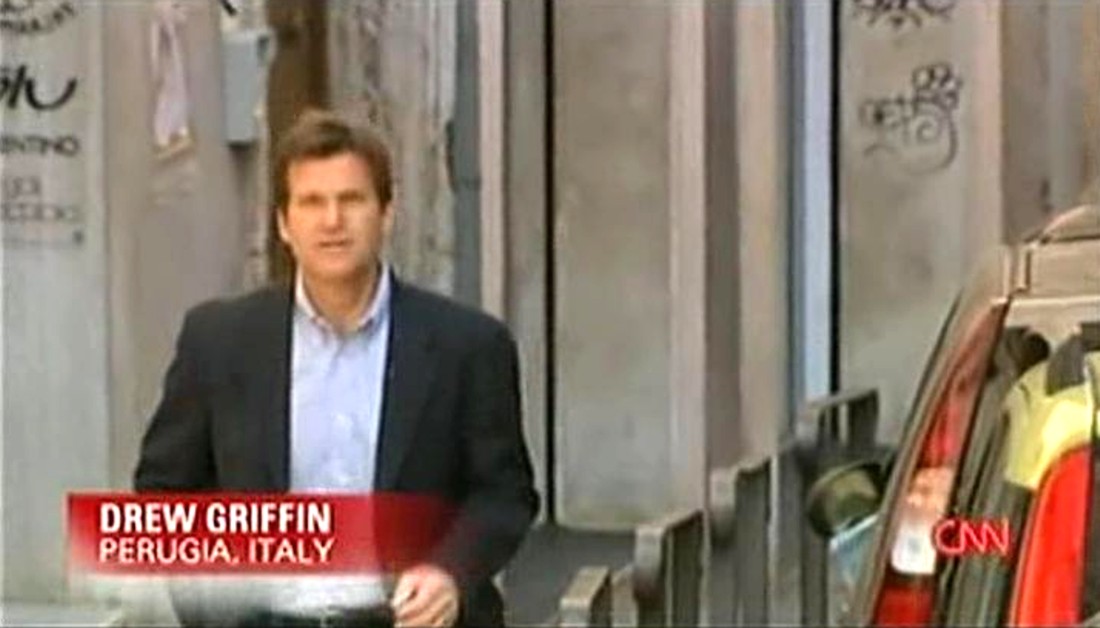
Points of error and omission in the report in the order in which they arise
(1) The most vital document on the case of all, a 427 page judgment on Knox and Sollecito known as the Massei Report, which can be viewed via the link at the top here, was not mentioned at all. It seems that neither Drew Griffin nor any of the programme’s producers have ever cast an eye over this document. If they have, they have blithely ignored it.
The Report contains a detailed resume of the evidence presented at Amanda’s trial and the jurors’ evaluation of it. It does not cover all the evidence that was heard by the court, which was huge, but certainly that sufficient to warrant the verdicts that were handed down.
There are also at least two other vital documents, also ignored, which all set the stage for the present mandatory appeal. They are the Micheli report on Rudy Guede’s judgment, and a recent Supreme Court report endorsing that report and accepting that there were THREE perpetrators of the crime.
(2) There was a photograph of the cottage. In fact, in all there were seven still shots of the cottage, and two showings of a film of the cottage, taken from a vehicle approaching along the road outside from right to left, from east to west.
All had one glaring omission in common.
None showed the west side of the cottage with Filomena’s bedroom window through which Rudy Guede is supposed to have broken in. That this was blatantly intentional was demonstrated by the editing of the film which cut out just as the side of the cottage with the window was coming in to view.
(3) The staging of the break in was a crucial piece of evidence against Amanda Knox dealt with at some considerable length in the Massei Report. Quite apart from that, it is evident from a simple inspection that the climb up to the window would have been extremely difficult and dangerous for even an athletic burglar and indeed there is much evidence that this was not attempted (Massei).
It would have been far simpler for Rudy Guede, a frequent visitor to the boy’s flat on the lower floor of the cottage, to have broken into the girls’ flat via the balcony (as seen in the still shots) on the other side of the cottage. He could have done that unseen and unheard in well under one minute.
The glass window was not shattered by a rock thrown from the outside, because the clothing tossed inside the bedroom had glass on top of it, which in itself is hard evidence that the break-in was staged. That such a break-in was highly improbable was demonstrated by an attempt by the defence to reconstruct the climb up to the windowt that failed miserably.
The only person who could have had an interest in staging a burglary would be one of the occupants of the flat. This is a sore point for Amanda’s supporters, amongst whom I must now assume are Drew Griffin and the producers of Murder Abroad.

(4) It was good to hear from Dr Hampikian that the “police did a good job in processing the crime scene and collecting evidence”. Unlikely that on the basis of this observation he will be making any submissioms to the two independent DNA experts appointed by the court to review the DNA evidence concerning the knife and the bra clasp. Particularly as his other observations were quite ludicrous or fell outside his field of expertise.
Consider this: “They didn’t like the way Amanda behaved, whatever that means, and so they wanted to investigate her, and Raffaele and her boss. When the DNA is finally processed it is not any of their suspects. And so what do you do? What would you do? [laughing] You let them go.”
Really?
Can he, you, or anyone else, think of a police force anywhere in the world which would want to release a suspect in circumstances where a staged burglary, inappropriate behaviour and language pointing to an insider’s knowledge as to the circumstances and manner of the victim’s death, an alibi that no longer held up, and the framing of an innocent man for murder, clearly points to her involvement.
In addition there was early evidence of Amanda’s blood in the bathroom next to the Meredith’s bedroom, as a drop on the sink faucet and mixed with Meredith’s blood elsewhere. Contrary to Dr Hampikian’s contention (and he is not a lawyer) there was sufficient evidence to charge or at least prefer a holding charge pending further investigation. This happens frequently in the USA and UK. In addition Dr Stefanoni was aware that there was further evidence to be collected from the crime scene.
In murder cases suspects are very rarely released on bail for fear that they may abscond. Particularly a suspect who is not resident in the country.
A question for Dr Hampikian. How would you like it if a suspect in the murder of your daughter was granted police bail and skipped the country to return home and evade justice? Make no mistake about it. That is what would have happened.
(5) The DNA evidence was not finally processed, as Dr Hampikian knows, until after the final DNA evidence was collected on the 18th December, weeks after Amanda’s arrest. That was when the bra clasp was collected together with samples from traces identified by luminol. That delay was entirely attributable to the necessity of having to arrange for the defence lawyers and experts to be present to collect further samples, and not incompetence on the part of police or prosecution.
“Forensic expert Greg Hampikian says finding DNA (Amanda’s and Meredith’s) but no blood makes it highly unlikely that the knife was used in a bloody murder. He also says it is surprising that the prosecutor was even allowed to admit such a small unexplainable sample (Meredith’s on the blade) as evidence.” “Would this have made it into a US court? I don’t think it would have made it into a US lab report”.
Not make it into a lab report? Is he trying to be funny?
(6) Well there is the evidence of the police that the knife smelt heavily of bleach which, with its particular size and the fact that it looked so clean, was what made them interested in it. How many people wipe down an item of kitchen cutlery with bleach? I do not know but in my lifetime I have never known anybody do this. Washing up liquid works just fine for me.
Dr Hampikian is of course referring to the Low Copy Number (cell count) DNA reading but the fact is that the graph produced by the DNA electropherogram was a clear match for Meredith’s DNA profile.
Dr Hampikian might be interested to know that LCN DNA is admissible in evidence in at least one jurisdiction in the USA and there is growing support for it with the advances in DNA forensics. The majority of the experts who testified at the trial said that it was clearly Meredith’s DNA.
(7) Furthermore Raffaele explained the existence of the sample by saying that he had accidently pricked Meredith with the knife whilst cooking at his flat. Untrue. Amanda herself testified that Meredith had never been to Raffaele’s flat, and there was no evidence that she had. Nor was there any evidence or suggestion that, prior to the murder, the knife had been to the girl’s cottage.This evidence would in most courts make the DNA evidence admissible.
(8) Dr Hampikian again, on the bra clasp (with Raffaele’s DNA on it) ““ “If that’s all there is it’s a very weak piece of evidence”. “And it’s inconsistent with every other piece of evidence in the case”.
Well, there is the bloody footprint on the bathroom mat which the trial court accepted as being consistent with Raffaele’s footprint rather than Rudy Guede or, for that matter, Amanda. As to the DNA on the bra clasp this was, in forensic terms, an abundant amount, and no one, but no-one, has disputed that this was Raffaele’s DNA.
Perhaps Dr Hampikian can explain how Sollecito’s DNA comes to be there considering that his DNA was not found anywhere else in the flat (other than on a cigarette stub in the kitchen and on Meredith’s door handle) in a quantity even close to the amount found on the bra clasp?
He was clearly advancing the lone wolf theory espoused by Amanda knox supporters given that Guede’s DNA was found in Meredith’s room and on her person. Funny how that DNA evidence is accepted by them but the bra clasp DNA is not. As a forensic biologist perhaps he might also want to comment on the fact that ““
(9) There was not one single trace of evidence, DNA, fingerprint, footprint or otherwise, relating to Guede found on the window sill, window, glass, or any item located in, or anywhere else in, Filomena’s room. And yet a mixed sample of Amanda’s and Meredith’s DNA was found on the floor there. Explain that!
Without question Dr Hampikian’s soundbite contributions to the program were scientifically very inept for someone in his position, but I am sure that he knew what he was doing.
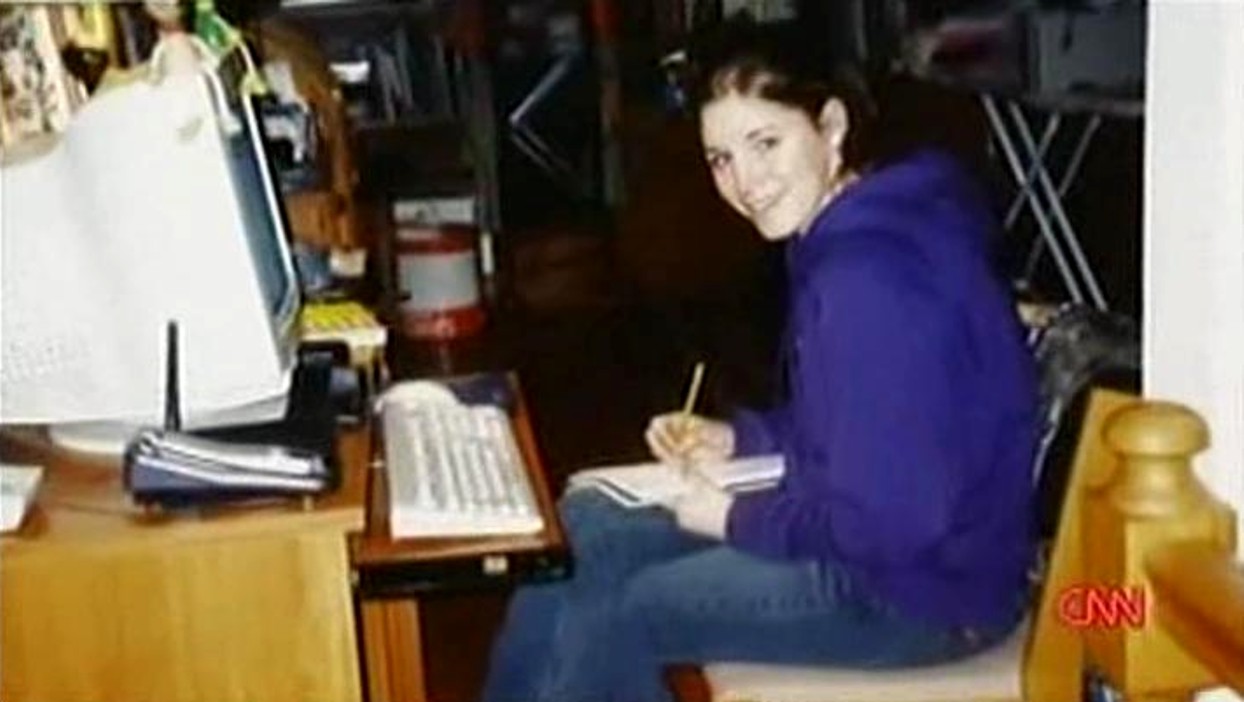
(10) Drew Griffin’s loaded, error strewn and unsubstantiated commentary continued -
- DG: Amanda was “confronted (by the police) with evidence of criminal activity which the police didn’t have.”
Amanda was questioned by the police as a witness in the immediate aftermath of the discovery of the murder along with others such as her flatmates Filomena and Laura, and Raffaele and three of Meredith’s English girlfriends. These were not interrogations. The questioning of Amanda for 52 hours (suggesting intensive interrogation) as mentioned by her father at the beginning is an exaggeration if not a fabrication.
Amanda was questioned (interrogated, if you like) at the police station on the 5th November from around 11.30pm to 1.45 am when the questioning stopped because she had become a formal suspect due to her disclosure that she had been at the cottage when Meredith was being murdered by Patrick Lumumba. She was not questioned again other than in court.
A question for Drew Griffin. “During the aforesaid period what evidence was she presented with that the police did not already have?” I, for one, do not know what he is talking about.
- DG: “The case against Amanda Knox appears to be falling apart.”
Really? News to me.
- DG: “The tabloid press is beginning to tell a different story.”
Well, they are reporting (and sensationalising in some cases) developments (such as they are) in the appeal. But a different story? Again news to me.
- DG: “The case against Amanda Knox and Raffaele Sollecito seems to be hanging on two very small pieces of DNA evidence.”
Actually Drew, that’s what you would like people to think. It would be far more accurate to say that it is the validity of any defence that is hanging on this evidence, and that what crumbs they may be thrown as a result of the review will not really damage that evidence nor alter the soundness of the convictions.
There is plenty of other evidence, all omitted in this biased documentary.
(11) Drew Griffin next remarks: “Curatolo’s evidence was laughable”.
Really? In what way? He seems to have got the date and times and identifications right. Explain that. In fact whatever the appeal court now makes of his testimony there was nothing laughable about his evidence. He was indeed confused in parts but very clear that he saw Amanda Knox and Raffaele Sollecito arguing together in Grimana Square the night before the police and forensic teams arrived in the square and at the cottage.
The confusion that arose was that he introduced elements of Halloween (the night before that) including a costume he saw in his recollection of the said night. However he was also certain that it was not raining when he saw the two together. It did not rain on the night of the 1st November whereas it did on the night of the 31st October.
- DG ““ “He revealed that he was under investigation by Mignini’s office at the exact moment he became his star witness.”
I sensed several slurs coming up and I was not wrong.
- DG ““ “Did he get any favours?
Like what? The promise of a reduction in sentence? It looks like he didn’t.
- DG ““ “So you believe the testimony of a homeless heroin dealer?”
Yes, for the reasons given. Drew, it does not matter what Mignini really believed or believes now. Testimony is heard and evaluated by the court not by prosecutors. Mignini is not heading the prosecution team on the appeal and he certainly has no influence otherwise on judges and jurors anyway.
(12) Another fatuous claim. “But almost immediately after the arrests Mignini had a problem. The third suspect, Patrick Lumumba had an airtight alibi. He was in his crowded bar that night. He could not have been involved.”
Actually the bar was not so crowded. Pretty empty really. Patrick was fortunate that of the few customers who turned up one was a Swiss professor, Roman Mero, who travelled all the way back from Zurich to give police Lumumba’s airtight alibi. But for that Lumumba might have stayed in the frame-up longer thanks to Amanda. She did not ever admit to the police that she had lied about him.
(13) Another fatuous claim. “Knox stated that she was denied a translator when referring to her interrogation/arrest.”
Knox testified on the stand in June 2009 that she DID have a translator at that time, by the name of Anna Donnino.
(14) We then had the introduction of Doug Preston, co-author of “The Monster of Florence” (another inadvertent plug ““ sorry) whose book is in the planning stage for a movie with a star role for this financial donor to The Committee to Protect Journalists. Preston is to be played by George Clooney in the movie.
I do not intend to dwell on this section. It is irrelevant to the Murder of Meredith Kercher and to do so would be to give this pompous individual more of the self publicity he craves It’s sole purpose was to portray the Perugia police and in particular Mignini as arch villains. It might occur to many that Doug Preston has a financial interest in doing this.
We were treated to the following gems ““
“Police interrogated people brutally and extracted suspect confessions from them” (in the Monster of Florence case ““ sorry, another plug)
“I was terrified. I thought these people have the power to put me in prison for the rest of my life.”
Mr Preston obviously does not like having to answer questions or to have to account for himself. Well nobody does really but we are in wimp territory with Preston.
George Clooney could not possibly play such a wimp. Instead the scene in the movie will have to be “sexed up” with Mignini being portrayed as overbearing, obsessive, corrupt and demented.
Hardly the picture he presented in his interview - that is, the two hour long interview that was not shown.
It is not accurate to say the Preston has never returned to Italy as a result of his brush with Mignini. He has been back with Dateline NBC to tape a show on the Monster of Florence (4th and last plug!).
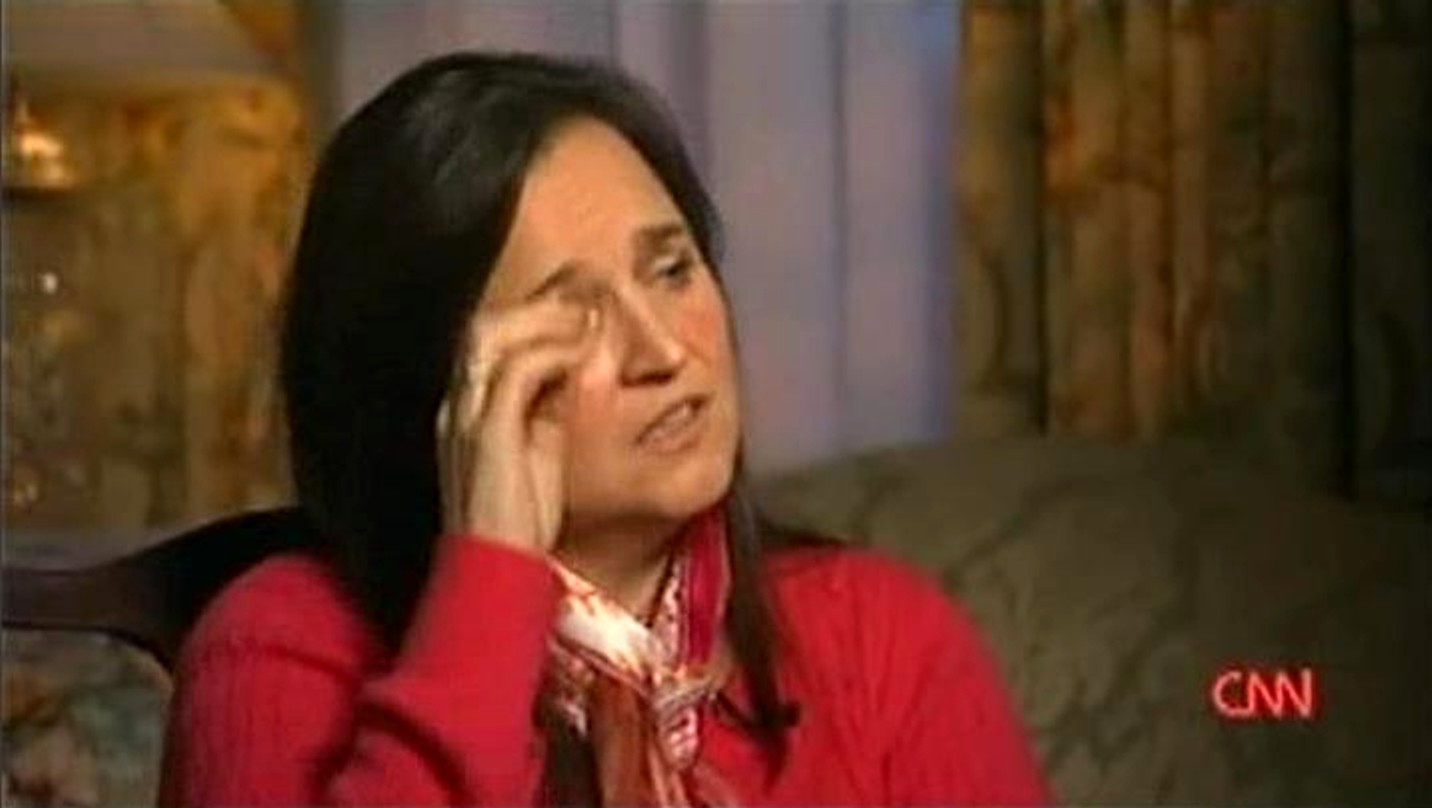
The following are some of the other facts omitted - all pursuant to testimony at the trial or verifiable from other easily obtainable sources. Take note first that there were extensive investigations by experts of cellphone and computer activity and their findings were admitted as evidence. Also it may be helpful to know that Meredith Kercher had two mobile phones, an Italian phone given to her by Filomena and her own UK phone.
These were stolen by her killers and discarded elsewhere. However they were found and handed in to the Postal Police who ascertained that the Italian phone was registered to Filomena and consequently two officers were dispatched to the cottage where they found Amanda and Raffaele.
(15) the fact that Amanda claimed that she returned to the cottage on her own at 10.30 am before the discovery of Meredith’s body to have a shower and collect a mop to clear up a spill of water at Raffaele’s flat the night before”“ which Massei found unlikely given that by her own testimony she had arranged with Raffaele to visit Gubbio that day and had testified that she had already had a shower at Raffaele’s the evening before; and furthermore that Raffaele employed a cleaner who kept a mop and cleaning equipment at his apartment block.
(16) the fact that cell phone records show that Amanda called Filomena at 12.08 pm (on the 2nd November) to report the front door being open, blood on the bathroom mat and Meredith’s door being locked. She was at Raffaele’s flat at the time. Filomena tells her to try Meredith’s phones. Records corroborate that Amanda did call each of Meredith’s phones in turn,
But these two calls lasted just 3 seconds and 4 seconds respectively. Does this sound like a genuine attempt to get hold of Meredith? One also has to wonder why she did not attempt to call Meredith’s phones again once she and Raffaele had arrived together at the cottage when she might have assumed that they would be heard ringing in Meredith’s bedroom.
(17) the fact that Amanda and Raffaele claimed that Raffaele had called the carabinieri to report a burglary before the postal police arrived. This 112 call was later discovered as timed at 12.51 pm after the arrival of the postal police.
(18) the fact that Amanda told the postal police that Meredith always locked her bedroom door even when she went to the bathroom. This was flatly contradicted by Filomena who said that the only occasion when Meredith had ever locked her door was when she returned to visit her mother in England.
(19) the fact that when the postal police looked into Filomena’s bedroom Raffaele told them that nothing had been stolen. That was true - but why had he been so certain?
(20) the fact that Amanda telephoned her mother from the cottage at 12.47 pm (around 4 am in the morning Seattle time), before the discovery of the body. Why did Amanda wake her mother up in the middle of the night? Edda was subsequently puzzled as to why Amanda was unable to remember this call when, as she put it “Nothing had really happened”.
Amanda persisted even with her parents in denying the existence of the call, but then eventually said that she could not remember it.
Edda says that Amanda mentioned in the call that there appeared to have been someone in the cottage, and that she told Amanda to call the police. Amanda did not mention, according to Edda, that the postal police were already there.
(21) the fact that in her 2,900 word e-mail home of the 4th November she professes to have been in a panic about Meredith’s locked door and her whereabouts (calling out her name, banging on her bedroom door, and running out on to the balcony and leaning over the rail and trying to look through Meredith’s bedroom window), but according to the witnesses exhibited no particular concern about Meredith when the postal police arrived, nor raised any concerns with them, rather quite the opposite, before the discovery of Meredith’s body.
(22) the fact that in the same e-mail she says that during her 10.30 am visit to the cottage she noticed the blood “smeared” on the sink faucet, drops in the sink and the bloody foot print on the bathmat. “Ew! but nothing to worry about” she says. She attributes the blood to perhaps Meredith having menstrual issues.Does that really make sense? A footprint in menstrual blood? Meredith? who was always so clean and tidy and who had admonished Amanda for her uncleanliness in the bathroom.
(23) the fact that she claims in the e-mail that Raffaelle tried to force Meredith’s door before the arrival of the postal police and failed, despite the fact that one of the other witnesses forced it quite easily.
(24) the fact that (if Amanda’s account of returning to the cottage at 10.30 am is to be believed) notwithstanding blood in the bathroom (which by Amanda’s own admission was not there when she left the cottage the day before), the front door being open, Meredith’s bedroom door being locked (when it was usual for it to be unlocked),and unflushed feces in the large bathroom toilet (which,she says, made her feel uncomfortable about the situation), Amanda did not think of attempting to contact Meredith by phone (on the assumption that she had gone out that morning) nor take a decision to notify anyone other than Raffaele for up to an hour and a half, until a 12.07 call to Meredith and the 12.08 phone call to Filomena. Does this seem credible?
(25) the fact that the 12.07 call was to Meredith’s UK phone and lasted 16 seconds but oddly she does not mention this call to Filomena seconds later. Nor, before calling Filomena, does she try Meredith’s italian phone. The italian phone was, Amanda knew, the phone Meredith used to make and receive local calls. Massei infers that there was no need to try Meredith’s italian phone because Amanda knew that both phones had been disposed of together. This explains why the first call (immediately prior to calling Filomena) was 16 seconds long (to check whether or not both phones had been found), and why the subsequent two calls (after the call to Filomena) were both very short.
(26) the fact that Filomena was worried enough to call Amanda twice at 12.12 (36 seconds) and at 12.20 (65 seconds) without Amanda picking up the calls. Amanda did pick up the final call at 12.34. Why did she not answer the first two calls?
(27) the fact that Amanda told Meredith’s English friends at the police station details of the body and wounds, although but for a foot it was covered by a quilt and despite her not being in line of sight when the body was discovered, and not having been told any of these details by anyone afterwards.
(28) the fact that when 3 days after the murder Amanda, Filomena and Laura were requested by the police to accompany them to the cottage to check out some details, Amanda, on being shown a drawer of knives in the kitchen, appeared to have had a psychotic incident, putting her hands over her ears and trembling.
(29) the fact that Raffaelle told a British Sunday newspaper in an exclusive interview that on the night of the murder he was at a party with Amanda and not at his flat. He also said that Amanda had gone back to her own flat the next day at midday, and not at 10.30am as she claimed.
(30) the fact that having told the police that she had been with Raffaele all night on the 1st November, sleeping with him until 10.00 am the next morning, Raffaele then proceeded to destroy this alibi on the evening of the 5th November by telling the police that on that night Amanda had gone out and had not returned to his flat until 1 am.
(31) the fact that Raffaele’s own alibi was not corroborated by computer evidence. He claimed to have spent the night indoors, using his computer until late and then going to sleep. In fact all human interaction with the computer ceased at around 9.15 pm and the computer was not re-activated by him until 5.32 am the next morning when it was used for half an hour for music to be played.
(32) the fact that both Amanda’s and Raffaele’s mobiles were switched off sometime shortly after 8.42 pm and were not switched back on again until after 5.32am in the case of Raffaele who activated a text message his father had sent him late the previous night.
(33) the fact that Raffaele’s father had telephoned Raffaele at 8.42 pm and had testified that during the conversation his son told him that while he was washing the dishes he had noticed a leak of water on the floor. This times the dinner Amanda and Raffaele had together as being prior to this whereas Amanda had claimed first that dinner was a liitle after 9.15 pm and then again that it was quite late, perhaps 11 pm (close to the time that Meredith died).
(34) the fact that Amanda’s claim that she slept in until 10 am does not fit easily with the fact that Raffaele was playing music on his computer from 5.32 am nor with the evidence of Mr Quintaville, the food store owner, who says he saw Amanda when he was opening up his store at 7.45 am.
(35) the fact that Amanda and Raffaele were both using drugs. There were multiple corroborating statements to that effect.
(36) the fact that Amanda and Raffaele were constantly together ““ in a symbiotic relationship as Massei put it.
(37) the fact that Raffaele was a knife aficionado in the habit of carrying a pocket penknife. Indeed he was carrying one on him when he was interviewed at the police station on the 5th November.
(38) the fact that Raffaele watched animal porn videos and this so concerned his university that his subsequent behaviour was monitored.
(39) the fact that Raffaele posted a picture of himself on Facebook dressed up as a mummy carrying a butchers’ chopper.
(40) the fact that Amanda had also written a bizarre short story about the drugging and raping of a young girl which she had posted on her web page.
(41) the fact that Amanda and Raffaele have both suggested that the other might have committed the crime.
(42) the fact that when Rudy Guede was arrested Raffaele did not celebrate his pending imminent release but wrote in his diary that he worried that this man, whom he says he had never met, “might make up strange things about me”.
(43) the fact that there are two instances of Amanda’s DNA mixed with Meredith’s identified by luminol (a powerful presumptive test for blood); in the corridor and in Filomena’s bedroom. The luminol also identified three footprints, one in Amanda’s bedroom and two in the corridor which tested positive for Meredith’s DNA, the footprints being comparable to the shape and size of Amanda’s right foot.
(44) the fact (as mentioned by me before but not in your programme) that Amanda’s blood was found in the bathroom. Amanda’s blood was on the washbasin faucet, and the mixed blood of Amanda and Meredith was in the washbasin, the bidet, and on the cottonbud box.
(45) the fact that not only was Raffaele’s DNA found on the bra clasp but that in the electropherogram chart there were ten out of sixteen loci having peaks corresponding to Amanda’s profile. Though this is not as decisive as the DNA result for Raffaele, it does give rise to the hypothesis that Amanda touched the bra clasp as well. Amanda’s defence team may consider themselves fortunate that the bra clasp can not be re-tested.
(46) the fact that a shoeprint on Meredith’s pillow was estimated in the area of size 37, or 38. Amanda’s shoe size, not the other two.
(47) the fact that (according to Massei) the nature of the wounds and injuries sustained by Meredith ( who was a fit girl and who had trained in karate) meant that more than one attacker had to be present to inflict those ( knife wounds, strangulation, bruising to her lips and inner thighs) and to subdue her and attempt sexual intercourse.
(48) the fact that Massei also concluded from the wounds that there were at least two different knives used and that exhibit 36 (the knife on which Amanda’s and Meredith’s DNA was found) was compatible with the wound that ultimately caused her death through blood loss and asphyxiation.
(49) the fact that there were blood spots (from coughing up blood as a result of the fatal knife wound to the throat) on Meredith’s chest and bra. This and other evidence shows that her body was moved, and her bra and some other clothing removed after she had died or at least as she lay dying.This suggests that the evidence of a sex attack is, in part at least, staged.
(50) the fact that there was a footprint (Raffaele’s) in Meredith’s blood on the bathmat but none leading from Meredith’s room to the bathroom. Highly suggestive, if not proof, that there had been a clean up operation.
(51) the fact that the discovery of Amanda’s arced reading lamp in an upright position on Meredith’s bedroom floor (as if for close inspection) is also highly suggestive of a staging or clean up operation.
(52) the fact that Meredith’s stolen mobile phones were found in a garden within a few hundred yards of Guede’s and Raffaele’s apartments. The apartments are within 30 seconds walking distance of each other, much closer to each other than either are to the girl’s cottage.
(53) the fact that the other two girl occupants with keys to the flat had rock solid alibis whereas Amanda had not.
(54) the fact that according to witnesses the relationship between Meredith and Amanda had started out well enough but had started to deteriorate, be it over petty things.
(55) the fact that the placing of a duvet over Meredith’s corpse is indicative of some relationship between Meredith and her killer.
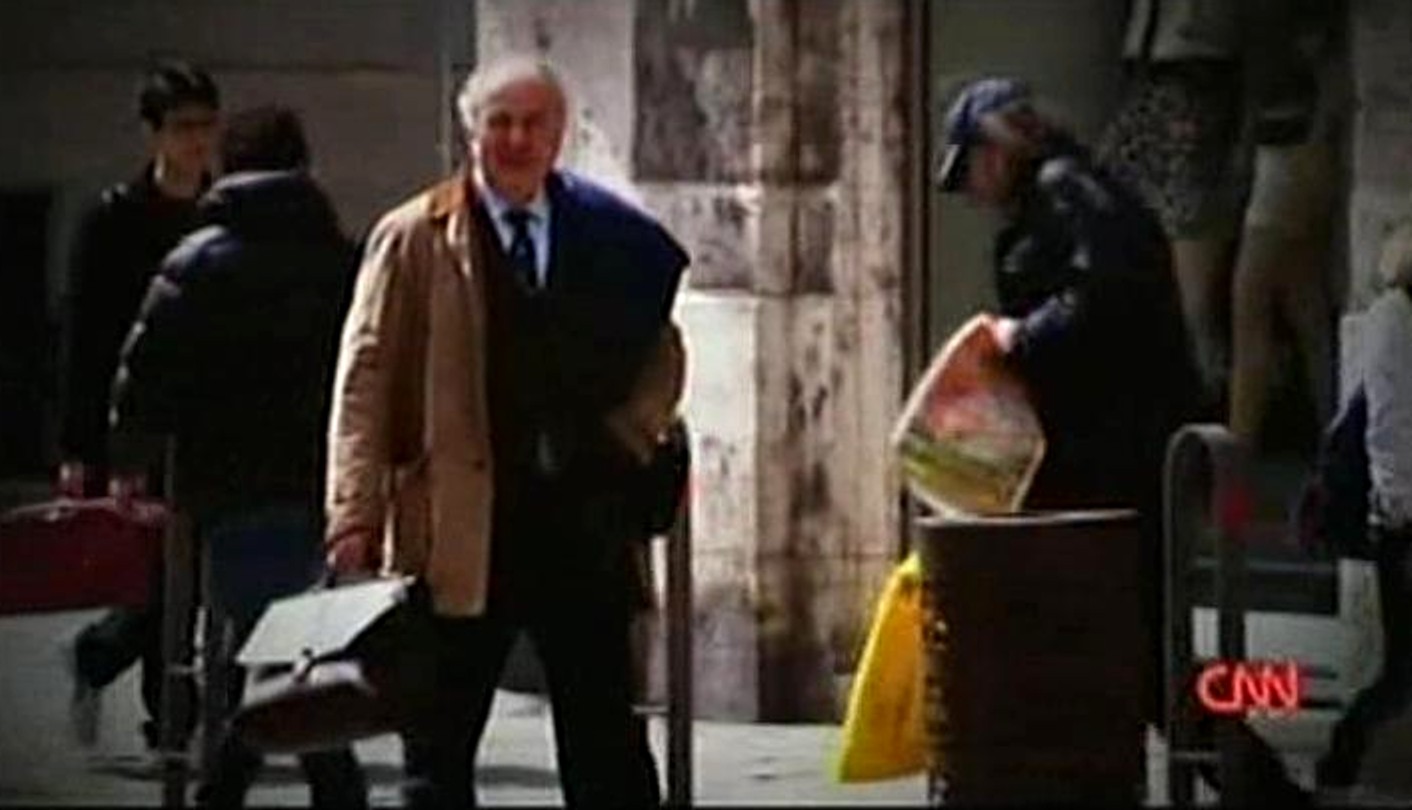
Some conclusions on the case and Griffin report
Most of the foregoing may be circumstantial evidence, but taken together it is powerful circumstantial evidence, more than enough to secure a conviction in any court in the USA.
Who would have the motive to stage a break in, stage further evidence of sexual assault for an invesigator’s benefit, carry out a partial clean up, and lock the victim’s bedroom door?
Curatolo’s evidence that he saw Amanda and Raffaele in Grimana Square, a few metres away from the cottage, having what appeared to be a heated argument, at various times between 9.30pm and 11.pm, is helpful to the prosecution case but by no means essential.
All the emphasis on the admittedly unhelpful and salacious tabloid newspaper reporting is irrelevant. It is a distraction.
In addition Rudy Guede, in his evidence, did indeed implicate Amanda Knox (starting well before the Italian police got their hands on him), and all the evidence from his fast track trial and appeals is now part of the evidence to be considered in the current appeal.
I think that the Italian Justice system would resent the insinuation in the programme that Guede received a reduced sentence because he was co-operative with the police and prosecution in implicating Amanda.
It should be noted that if Mignini, in his alleged rush to judgement, got things seriously wrong, then he would have had to manipulate the evidence of the prosecution witnesses to fit his erroneous hypothesis. A grand conspiracy! - a laughable hypothesis. The following is a list of such witnesses. It is indicative, not exhaustive.
Filomena Romanelli, Marco Zarelli, Paola Grande, Laura Mezetti, Luca Altieri, Inspector Battistelli (Postal Police), Monica Napoleoni (Head of Perugia Murder Squad), Sophie Purton, Robyn Butterworth, Amy Frost, Jovana Popovic, Antonio Curatolo, Marco Quintavalle, Nara Capezzali, Antonella Monacchia, Inspector Finzi, Superintendent Gubbiotti, Commissioner Bartolozzi, Marco Trotta, Claudio Trifici, Gregory Mirco, Dr Luca Lalli, Chief Inspector Latella, Dr Profazio, Dr Patrizia Stefanoni (Police Forensic Service in Rome and prosecution DNA expert), and Dr Torricelli (DNA expert for the Kercher family).
This particular murder case is unusual not just in the interest it has generated worldwide but also to the extent to which it has been discussed and argued over on the internet and in the manner in which on occasions it has been presented (rather than reported on) in the media. It is also unusual that the family of one of the accused has not only taken part in such activity but has hired a public relations firm to help bring this about.
There have been a number of books already but I predict that in future a number of these, and the media generally, will also deal with these additional features of the case in some detail.
Sadly for CNN I expect that “Murder Abroad ““ The Amanda Knox Story” will often be quoted and held up as an example of how bad things got.
I dare say you are free to broadcast what you like and perhaps Drew Griffin’s presentation wrought an overpowering sense of injustice in viewers and improved ratings.
With hindsight, however, I am sure that CNN will regret this shoddy little “documentary”.
It would be nice to think, when Amanda’s conviction is upheld, that CNN will broadcast a detailed corrective documentary. I look forward to hearing from you.
Yours etc
James Raper
c/o True Justice for Meredith Kercher
Sunday, May 08, 2011
Questions For Knox: 15 Questions That Drew Griffin On CNN Tonight SHOULD Have Asked
Posted by The Machine
Drew Griffin’s CNN report on Amanda Knox (replete with dozens of basic errors) can be read in transcript here.
Welcome to migrants from CNN. If you want to form a seriously fact-based opinion, please read this group of posts and especially the one by the very smart lawyer SomeAlbi at the top.
Amanda Knox’s family and friends are notorious for running a mile rather than ever facing any hard questioning. This is unique in crime reporting on American TV where strong suspects and convicted felons otherwise invariably get roasted - heard of CNN’s own Jane Velez Mitchell and Nancy Grace?
So it’s a pretty safe bet that we have got right in advance (see previous posts below) what Drew Griffin’s report for CNN will be like.
It will undoubtedly be very biased and one-sided, with the vast majority of the interviews featuring members of Amanda Knox’s family and supporters being tossed a number of soft ball questions.
The program will no doubt shamefully try to manipulate the emotions of the viewers, with the seemingly obligatory footage of Edda Mellas crying and numerous images of Amanda Knox as a baby and child. None of this has anything to do with the evidence that led to her unanimous conviction.
And it will babble on ignorantly about Mr Mignini without an ounce of impartial investigation..
Don’t expect to see any images of Amanda Knox that undermine her carefully crafted girl-next-door image. Such as the footage of her kissing Raffaele Sollecito outside the cottage whilst Meredith’s mutilated body was still inside, and such as the CCTV images of Knox laughing and kissing Sollecito in the boutique as if she didn’t have a care in the world.
I have listed below a number of tough questions that Drew Griffin should, but its a very safe bet won’t, ask Amanda Knox’s family. First, a couple of vital context facts.
1. The various alibis
Amanda Knox and Raffaele Sollecito both gave at least three different alibis, all of which have turned out to be false. Nobody has ever provided a plausible innocent explanation for the numerous lies that Knox and Sollecito told before and after 5 November 2007.
Amanda Knox told Filomena that she had already phoned the police. Knox’s mobile phone records proved that this was untrue.
She told the postal police that Meredith always kept her door locked. Filomena strongly disagreed with her, and told the postal police the opposite was true.
And in her email to friends in on 4 November 2007, Amanda Knox says she called Meredith’s phones after speaking to Filomena. Knox’s mobile phone records prove that this was untrue and that she had called Meredith’s phones first.
Question for Knox: Why did Amanda Knox lie to Filomena and the postal police on 2 November 2007 and to her friends in her e-mail on 4 November 2007?
2. Sollecito’s alibi lies
On 5 November 2007, Raffaele Sollecito admitted to the police that he had lied to them and said that Amanda Knox had asked him to lie for her. He claimed that Amanda Knox had left his apartment at around 9.00pm and returned at about 1.00am on the night of the murder.
Question for Knox: Why did Sollecito stop providing Amanda Knox with an alibi and why does he still refuse to corroborate her alibi?
3. Sollecito’s further alibi lies
After admitting he had lied, Sollecito was given another opportunity to tell the police the truth. However, he decided to tell the police even more lies. These lies were exposed by his computer and mobile phone records.
Sollecito claimed that he had spoken to his father at 11pm. Phone records show that there was no telephone conversation at this time. Sollecito’s father called him a couple of hours earlier at 8.40pm.
He claimed that he was surfing the Internet from 11pm to 1am. There was no human interaction on his computer between 9.10am and 5.32am.
He claimed that he had slept until after 10.00am on 2 November 2007. However, he used his computer at 5.32am and played music for about 30 minutes. He turned on his mobile phone at about 6.02am and received three phone calls at 9.24am (248 seconds long) and at 9.30am and at 9.29am (38 seconds long).
4. The DNA on the bra clasp
An abundant amount of Raffaele Sollecito’s DNA was found on Meredith’s bra clasp. His DNA was identified by two separate DNA tests. Of the 17 loci tested in the sample, Sollecito’s profile matched 17 out of 17.
Question for Knox: Bearing in mind that DNA doesn’t fly, how would you account for the abundant amount of Sollecito’s DNA being on Meredith’s bra clasp?
5. The DNA on the large knife
Amanda Knox’s DNA was found on the handle of the double DNA knife and a number of independent forensic experts - Dr. Patrizia Stefanoni, Dr. Renato Biondo and Professor Francesca Torricelli - categorically stated that Meredith’s DNA was on the blade.
Question for Knox: How would you account for Meredith’s DNA being on the blade of the double DNA knife?
6. The traces of mixed blood
A number of criminal biologists testified at the trial that Amanda Knox’s blood was mixed with Meredith’s blood. Independent DNA expert Luciano Garofano stated that this was undoubtedly the case and even Amanda Knox’s lawyers conceded that her blood was mixed with Meredith’s blood.
Question for Knox: Why was Amanda Knox bleeding on the night of the murder and why was her blood mixed with Meredith’s blood in four different parts of the cottage?
7. Sollecito claims to cut Meredith
Sollecito claimed in his diary that he had accidentally pricked Meredith’s hand whilst cooking.
Question for Knox: Why do you think Sollecito lied about accidentally pricking Meredith’s hand whilst cooking?
8. Sollecito on Filomena’s room
Sollecito told the police that nothing had been stolen from Filomena’s room.
Question for Knox: How did Sollecito know nothing had been stolen from Filomena’s room?
9. Knox accuses Patrick
According to the corroborative testimony of multiple witnesses, including Knox’s interpreter, she voluntarily accused Diya Lumumba of murdering Meredith.
Question for Knox: Why did Amanda Knox voluntarily accuse an innocent man of murder?
10. Knox refusal to recant
She acknowledged that it was her fault that Diya Lumumba was in prison in an intercepted conversation with her mother on 10 November 2007, but she didn’t retract her allegation against Diya Lumumba the whole time he was in prison.
Question for Knox: Why didn’t Amanda Knox recant her false and malicious allegation against Diya Lumumba when he was in prison?
11. Knox at crime scene
Amanda Knox state on four separate occasions that she was at the cottage when Meredith was killed
Question for Knox: Why did Knox repeatedly claim to be there?
12. Knox’s Seattle call
Amanda Knox called her mother at 4.47am Seattle time before Meredith’s body had been discovered.
Question for Knox: Why did she phone her mother when it was in the middle of the night in Seattle and before anything had happened?
13. Knox forgets that call
Knox told her mother and the court that couldn’t remember making this phone call.
Question for Knox: Do you think Amanda Knox can’t genuinely remember phoning her mother at in the middle of the night?
14. Knox involvement
Amanda Knox voluntarily admitted her involvement in Meredith’s murder in her handwritten note to the police on 6 November 2007.
Question for Knox: Why did Amanda Knox voluntarily admit that she was involved in Meredith’s murder?
15. Knox calls Meredith
Knox claimed that when she called Meredith’s Italian phone it “just kept ringing, no answer”. Her mobile phone records show this call lasted just three seconds.
Question for Knox: Question for Knox: Do you think Amanda Knox made a genuine attempt to contact Meredith on 2 November 2007?
Explaining Why CNN Is So Desperate For A Hit And Quaint Niceties Like “Truth” Be Damned
Posted by Peter Quennell

[Above: Jeffrey Bewkes, the head of CNN’s owner Time Warner, with the actress Hayden Panetierre]
A top-rated night-time show on the American TV frontrunner network CBS will pull in over 10 million viewers.
Fast-tanking CNN is lucky if it pulls in over FIVE PERCENT of that audience on any average day. A typical audience is just over 1/2 a million. Here is the story from last September.
Jonathan Klein, president of CNN’s US network, leaves his post today after a sudden announcement that he has been replaced by Ken Jautz, the head of CNN’s downmarket but more popular sister channel HLN.
Klein’s departure comes after a disastrous year for CNN, as its daily ratings slumped by 36% to an average of 640,000 weekday viewers, putting it in third place behind Fox News and MSNBC among cable news channels.
Fox News averages 2.4m viewers while MSNBC has nearly 850,000. HLN averages around 550,000 on weekdays.
The American stock market knows of this CNN fiasco, and it values all three accordingly. You can see this in the 3-year chart just below - the period shown is about half that.
- The red curve below is for the US stock market average (the Dow Jones Index and you can see that it GAINED about 10 percent.
- The green curve below is for Viacom Corp, which is the owner of CBS, and you can see that it GAINED about 50 percent.
- The blue curve below is for Time Warner, the owner of CNN, and you can see that it LOST about 30 per cent in the same period.
We have no beef with CNN overall. But to try to boost its viewer ratings and stockmarket price with appalling reports on the back of the very sad death of Meredith? That seems to us to be in very sick territory.
Ironically CBS’s owner, Viacom, has seen its impressive recent gains since the CBS network STOPPED airing biased and misleading reports on the case and reacquired some integrity
The Meredith Effect?
Friday, May 06, 2011
Drew Griffin Report This Sunday At 8:00 Seems Intent On Sustaining CNN’s Persistent Extreme Bias
Posted by Peter Quennell
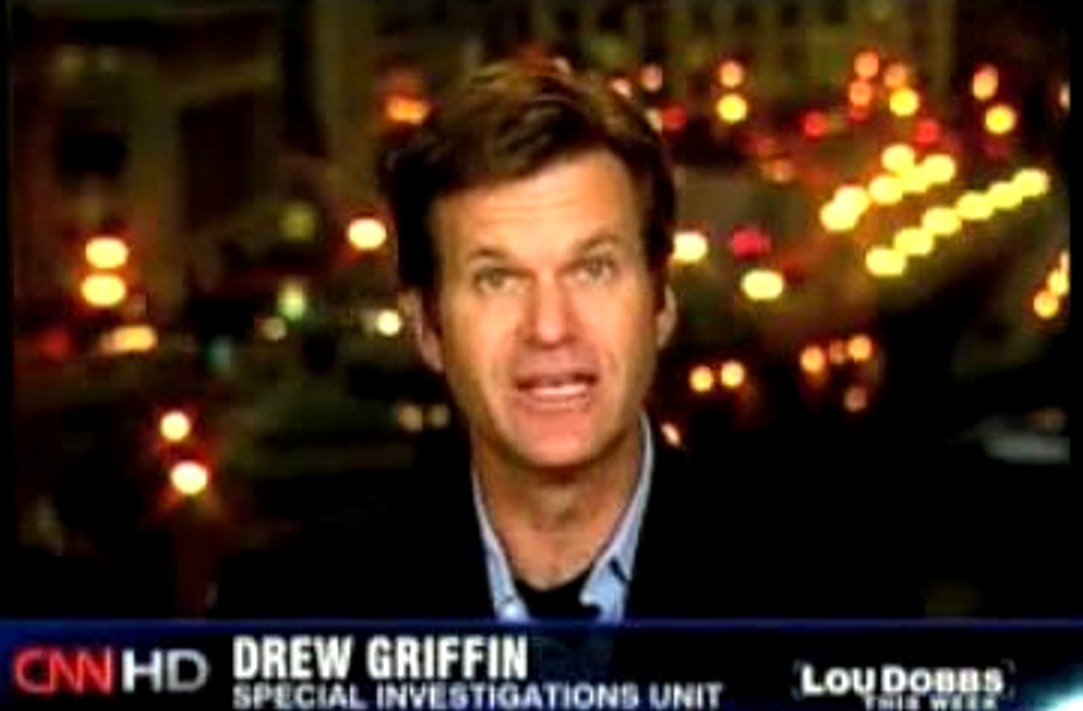
CNN and CNN International have aired more biased reporting and inaccurate commentary on Meredith’s case than all other US networks - combined.
At bottom here is a video of a typically biased CNN panel.
Jingoism, defamation and xenophobia remain pervasive throughout, though the videos for the worst of the worst - an entire CNN panel baying for Italian blood - have been mysteriously disappeared.
Larry King, Elliott Spitzer, Nancy Grace, Jane Velez Mitchell, Jeffrey Toobin, and so on and on, have all helped to seriously mislead CNN viewers about the real evidence, and about the very strong case against Amanda Knox and Raffaele Sollecito.
The Micheli Report and the Massei Report and the recent very hardline Supreme Court ruling on Rudy Guede stating that three people did it - all of those reports comprehensive, meticulous, and very damning - don’t even seem to have simply been MENTIONED yet on CNN.
CNN never seems to have had a competent legal reporter actually present in the courtroom. There is a very conspicuous lack on CNN of any Italian interviewees or legal analysts. CNN has seemingly never ever presented an accurate description of how cautious the Italian justice system really is, or how many hoops Italian prosecutors have to jump through.
No mention ever on CNN that the US State Department and Rome Embassy observed the trial and found absolutely nothing wrong. No mention ever on CNN that not one human rights and prisoners rights organization such as Amnesty International has ever shown interest in this case.
Here are about three dozen CNN headlines taken from CNN’s own website. Do you notice any suggestive pattern?
- Amanda Knox’s family speaks out
- Amanda Knox’s parents say their daughter is no killer
- Knox innocent, parents say
- Murder case brings ‘Foxy Knoxy’ infamy in Italy
- Knox scared but insists on innocence, Italian lawmaker says
- Sollecito: Amanda Knox ‘incapable of killing’
- Knox aunt: Italians supportive
- Is Amanda being railroaded?
- Amanda Knox tells Italian jury she’s not an ‘assassin’
- Lawyer: Vague theories and bias, but no evidence in Knox murder trial
- U.S. student testifies Italian police pressured her
- Amanda Knox’s parents hope acquittal is near in murder case
- Disputed evidence in spotlight as Amanda Knox trial nears end
- Amanda Knox lawyer makes emotional plea for acquittal
- Amanda Knox sobs as guilty verdict read
- Knox’s parents react to conviction
- Knox’s parents blame media
- Knox’s parents: ‘huge mistake’
- Amanda Knox: Court has made ‘huge mistake’
- Knox jury, prosecutor decried
- Knox ‘ready to fight on,’ parents say
- Knox family, friends react
- Amanda Knox’s aunt says hearing verdict was ‘gut-wrenching’
- Knox verdict leaves many questions unanswered
- Judge allows appeal in Amanda Knox case [actually it’s automatic]
- Jailed mobster claims he can prove Amanda Knox is innocent
- Knox’s mother reacts to libel case
- Knox’s mom: This feels personal
- Toobin: Knox libel charge ‘very strange’
Notice any bias in that list? You think CNN took the same position on the convicted brutal murderer Scott Peterson now on Death Row for whom there was actually much LESS evidence?
This sunday at 8:00 US east coast time, on CNN and CNN International, the aimiable and lightweight CNN investigative reporter Drew Griffin (image at top) will seemingly present an hour more of the same.
CNN investigative correspondent Drew Griffin reveals new details that cast doubts upon controversial blood, knife, DNA, and other evidence presented in Knox’s original trial….
Griffin also has a rare television interview with the chief prosecutor in the case, Giuliano Mignini, and reveals a pattern of prosecutorial behavior that raises questions about the original conviction.
He debriefs viewers on Knox’s now-disputed confession ““ obtained after days of unrelenting questioning, and according to Knox, even physical abuse by police interrogators.
Pattern of prosecutorial misbehavior? Really? A confession obtained after days of unrelenting questioning? Really? Which days precisely? And exactly what confession was that?
No mention at all that both Amanda Knox and her parents Curt and Edda now face separate calunnia trials in Perugia for serious wrong charges that were pretty well exactly like these.
Drew Griffin’s normal beat is aimiable, lightweight political muckraking. He apparently has not previously reported on crime or on court cases, or for that matter on Italy.
No matter. He simply gets told to follow the CNN party line - and like a robot, he does so.
Friday, April 29, 2011
Committee To Protect Journalists Responds, But Provides No List Of Sources Or Interview Transcripts
Posted by Peter Quennell
Click above for the response by Nina Ognianova. Comments are open below that CPJ post and both Kermit and Doug Preston have taken advantage, Kermit gracefully, Preston petulantly..
Nina Ognianova does not address Kermit’s contentions, though she did link to TJMK, and really responds only in broad generalties. She still leaves standing the smears of Giuliano Mignini and other Italian officials that the Committee to Protect Journalists chose to broadcast globally.
We can find zero evidence that CPJ interviewed anyone in Perugia, except presumably for the strenuously anonymous blogger “Frank Sfarzo” (real name Sforza) who the CPJ may actually realize now is not a real journalist and who posts mostly mischievous nonsense under an assumed name.
Nina Ognianova does not explain why neither Mr Mignini not anyone in the police or judiciary were interviewed before the CPJ smeared Mr Mignini in an open letter sent to Italy’s President and a number of other notables worldwide.
There’s been good commenting starting about here about this already on PMF where some are warming to the idea of a public hearing in Perugia (“Frank Sfarzo” goes on trial early in May)
Maybe “Frank Sfarzo” and Doug Preston can be made to finally put up or shut up. This may not be the result the hornswoggled Joel Simon was intended to deliver..

